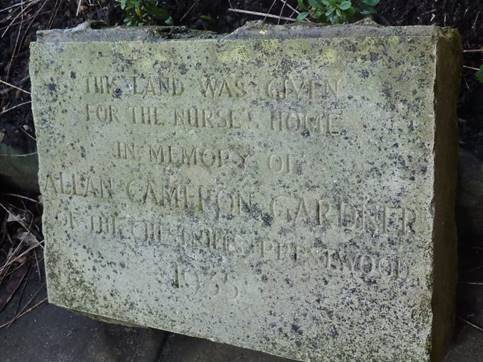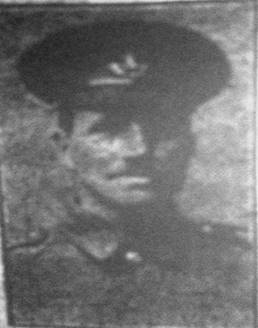10 The Community Builds, 1900-1950
Preface: Class of 1902
In the previous chapter was shown a picture of a Church School class of 1902. Later in this chapter is a photograph of another class in 1905. These were children born just before or around the turn of the century, their birthdates clustering around an average of 1895, their ages in 1902 ranging from 1 to 15. They represent the future of Prestwood at the very beginning of the twentieth century, a time of huge technological progress and massive social upheavals, none of which would have been foreseen by these children at the time, who must have accepted that things would be for them as they had been for their parents and grandparents, the people we have visited in detail in the last two chapters.
We are able to identify most of the children in these two class photos. They are mixed classes of 34 and 35 pupils respectively, with boys comprising about sixty percent. Each class had a mix of ages from the oldest to the youngest, but families were kept together, brothers and sisters in the same class. They do not represent a cross-section of the community at the time, as their fathers' occupations are better than average - a third were proprietors of local businesses and only a quarter were labourers or other unskilled workers. The children of farm labourers less often got the chance of being sent to school, partly because of the mobility of this section of the population and partly because they were needed from an age often as young as four to help contribute to meagre family incomes. (This would change within a few years with the coming of the first council school, as we shall see below, heralding universal education and, later in the century, a universal health service and welfare state, the two great reforms in the 1900s.)
But the biggest event that was about to unfold for these children was no respecter of social class. Most of these children were of the prime age for being called up when the first world war began in 1914. At least two-thirds of the boys saw active service. Sixteen percent would never return. One in six. Count them along the rows in the two photos and replace with gaps: the missing, "killed in action". This was what the whole community looked like by the end of war in 1918. Most families were of six or more children; most now had a gap where now there was only grief, and which would take time, much time, to heal.
Whatever was felt, however much time was taken to mourn and create memorials, the community nevertheless had to survive and economic activities and social life had to continue. The age of marriage in those days was densely clustered around twenty years old, especially for girls. The time of the first world war was therefore when most of the members of these two classes would normally have been expected to marry. Of the 37 children we can trace through later records, seven were married just before the war, only two during the war itself, and 28 afterwards. So for this generation, even for the survivors, marriage had to be postponed for up to four years. In time, over the decades, this would become no more than a blip in the statistics for the age structure of the population, but at the time it must have meant privation and anxiety, and sometimes physical loss. For the most part, despite the war, these people would lead the kinds of lives that might have been expected in the light of the technological changes then already moving forwards, although, especially for those boys who witnessed the horrors, the shadow would always remain. On average, the boys who returned lived to the age of 78, the last to die having done so in 1991, aged 91. The majority even spent all their lives, apart from the war, in their local community - only 41% of those that could be traced had left the immediate area of Prestwood, despite the fact that the C20th was a time of high geographical mobility.
The following are those in the two school classes that could be traced in the records, although, compared to the records for the earlier century that have been used in the last two chapters, they are only sparse, lacking the rich material of the available censuses 1841-1911, so that often we known only when they married and, for the men, when they died. (Women on marriage took the names of their husbands, not given in the freely available records, so that they cannot be traced further in most cases. This information could be obtained but only at inordinate cost from the point of view of this history.)





John Cummings. Born 1897. Brother to Ivy. Married 1921. Died locally in 1979.





Bertha Groom . Born 1897. Sister to Constance. Married at Holy Trinity Prestwood 1918.










Fred "Chum" Parsons. Born 1891. Brother of Dora. Could not be traced.

Fanny Parsons. Born 1894. Sister of Dora. Married at Holy Trinity Prestwood 1912.







Ernest Albert Redrup. Born 1893. Brother of George. Married at Holy Trinity Prestwood 1912. Died locally 1973.




Eva Saunders (right). Born 1895. Sister of Winifred above. Married locally 1918.
(Winifred and Eva had two brothers, William (below) and Bertie (above), shown in the class photos, but they could not be uniquely traced.)


Emily Rose Stevens. Born 1899. Sister of Annie. At Holy Trinity Prestwood in 1923 she married the local farmer Wren Davis, whose farming company survives to this day. She died in 1987. The diary of her school years is extensively quoted below in this chapter. (A brother Rupert, who does not appear in the school photos, was involved in WWI and his account of this is also quoted later.)

Sidney Stevens (left). Born 1898. Brother of Annie. Married locally 1925. In the 1930s he set up butcher's shops in Great Missenden, Denham and Aylesbury. He lived at The Limes in Prestwood in 1947 and died in 1970 at Aylesbury.






Isabel Elizabeth Timpson. Born 1899. Sister of Frank. Married, Holy Trinity Prestwood 1925.

Edwin Timpson (left). Born 1896. Brother of Frank. Killed in WWI.



Maud Wright (lower girl ). Born 1900. Sister to Sidney. Married at Holy Trinity Prestwood 1922.

In the 1905 photograph is also shown the headmaster of the school, William Henry Pitt. He had been born in Headington, Oxfordshire in 1865 and married Amy Charlotte Hannell of Great Missenden in 1900, who in the 1891 census is shown as a housemaid at Prestwood Lodge, where her father had been steward for twenty years. Pitt remained headmaster from 1900 through 1911 and was also organist at Holy Trinity Church during this time. Amy also taught at the school and is shown in the 1902 photograph. Both William and Amy died in 1942, having experienced two world wars.
Development in the Early Twentieth Century
In place of the vanishing horse came buses, lorries, vans, family cars, motor-cycles: nearly 1 million of them by 1922, more than 2¼ millions by 1930.
David Thomson “England in the Twentieth Century”
In 1900 Prestwood and the surrounding area was still in the horse and cart age.
"Water came from wells, it was without a sewage system and the village was lit with oil lamps. The roads were of flints or granite chippings. (Clarke, n.d.)
The Great Missenden Parish Council had been founded in 1895. Its early deliberations centred on allotments (particularly important during the First World War when food became scarce) and recreation grounds, the state of footpaths and roads (including obstruction by carts and herds of farm animals), wells, provision of a horse-drawn fire engine and a night soil cart (for collecting human excrement from privies and cesspits, often used as fertiliser - an early example of recycling). The first piped water came to Prestwood in 1902. By 1906, moreover, the motor car was having an impact and the Council decided to limit speeds to 10mph in the interests of safety. Driving was fraught for drivers as well as pedestrians, with narrow un-tarred roads, dusty or muddy according to the weather, and sharp bends. As early as 1915 the Council had to deal with complaints of vandalism to Prestwood Recreation Ground and Church Path, which were referred to the police. (Clarke, n.d.)
Even in 1900 one could still indicate individual houses and cottages of the parish on a small map without too much difficulty. By 1950, however, tracts of housing, whole estates, had come into being, making substantial areas of the map grey. The graph below, for Great Missenden parish, including Prestwood, shows the steep growth curve.
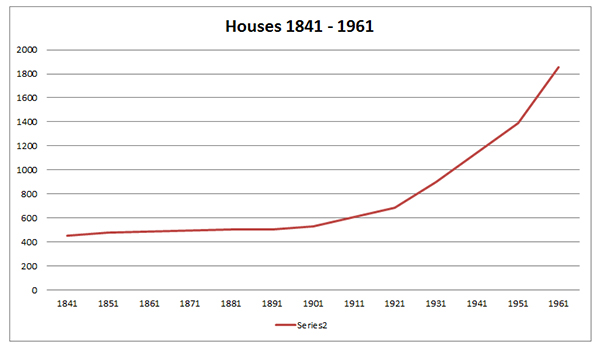
While Great Kingshill, Bryants Bottom, and the Perks Lane development were all part of this expansion, the greater part of the new housing in Prestwood Parish was in the village of Prestwood itself, especially close to or along the High Street (including several shops and a Post Office), on those fields that in the previous half-century had just been enclosed from Prestwood Common, and also along Wycombe Road and Nairdwood Lane leading south from the High Street. Initially these roads were little more than cart-tracks, sometimes with grass down the middle, although after the First World War and the growth of motor traffic they soon had to be upgraded to tarmac.
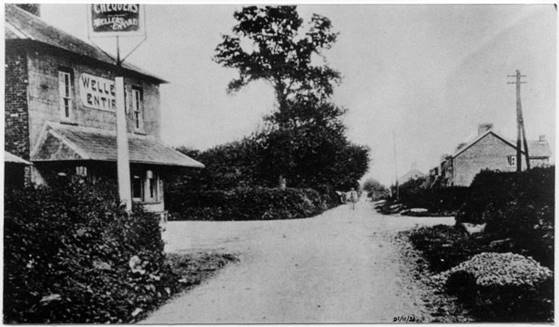
Picture taken early 1900s from the west end of the High Street, showing the Chequers Inn on the left and the first few buildings along the High Street (right). Wycombe Road begins on the right.
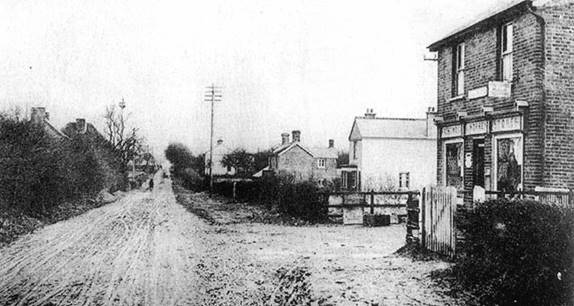
Picture taken c.1915 from just east of the Chequers, with Leslie Morren's "Prestwood Stores" and Post Office on the right, and showing the rutted condition of the muddy road. Morren's is now a private house, Maple Cottage, with Zoran's Bakery built in the gap between it and the next house, Excelsior Cottage, built in 1911 (see below). Leslie Morren had married Miriam Groom, a daughter of Solomon Groom, in 1906. After the Morrens the Post Office was run by Mr and Mrs Crook.
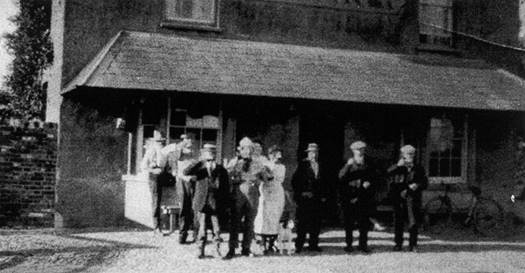
The Chequers 1911
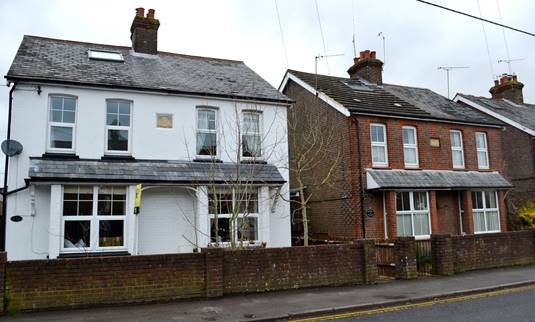
Montrose (1910) and Belmont (1911) Cottages (110-116 High Street). The new brick-built tall houses had a distinct utilitarian "square" architecture, contrasting with the flint cottages of the previous century.

Arlington Cottages built 1911 (102-108 High Street).

Excelsior Cottage (1911) has a more decorative exterior. Zoran's Bakery next door is of much later date
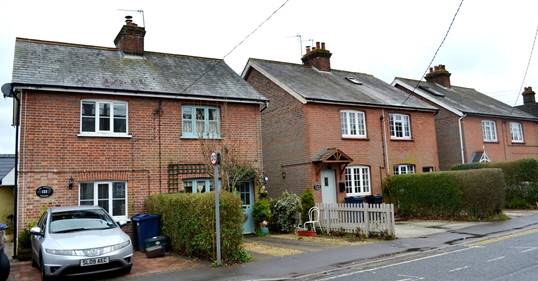
Chestnut, Christmas and Drover's Cottages (133-143 High Street), part of post-WWI development
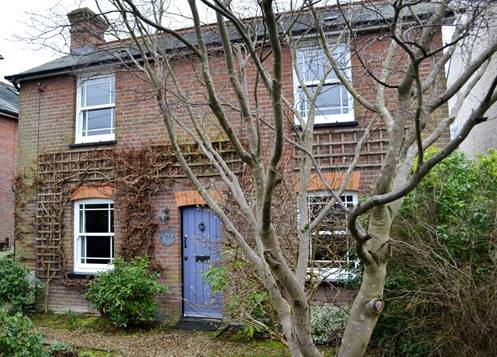
Maple Cottage (125 High Street), another post-WWI house

September & Ivy Cottages (77-79 High Street)
From 2,166 in 1901, the population of Great Missenden parish – which included the majority of Prestwood parish residents – more than doubled to 4,464 by 1951. Most of this development in Prestwood itself was smaller affordable housing in brick, a better quality building material than the traditional flint, although lacking the same visual character. (While one might bemoan the loss of an endemic building material like flint, one must remember that Prestwood was also a major brick-making centre, so that this also maintains historic associations and links with the native geology, even if many of the bricks used actually came from elsewhere.) Larger houses were built at Perks Lane (itself a new road) and the Grimms Hill estate just outside the boundary at Martins End – lining the road down to Missenden with well-spaced quasi-mansions with planted lawns and trees and sweeping driveways for their new cars. Nanfans was also enlarged as early as 1903, on the basis of plans by the young architect Giles Gilbert Scott, who was later knighted, like his father of the same name, designer of London’s Albert Memorial. North of Nanfans on Honor End Lane another large property, The Gables, was built shortly afterwards in mock-Tudor style.
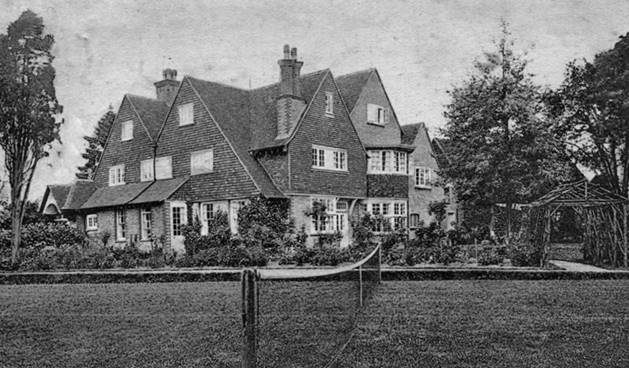
Nanfans and its tennis court in the early C20th

The Gables
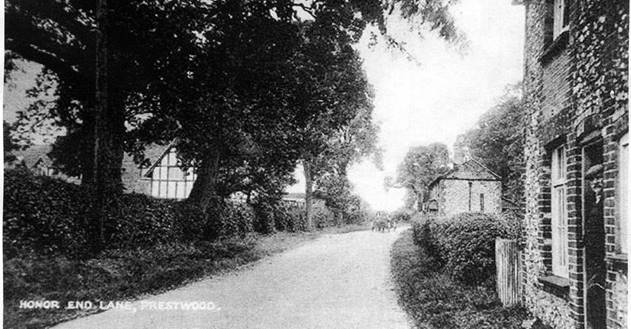
The Gables (left) was built in the early 1900s beside Honor End Lane, opposite the older cottages of Jasmine and Greenlands (in right foreground). The doorway in which the man is standing is now bricked up, but all these properties survive (see below).

Same view in 2018: many of the old oak trees to the left are gone, although one remains close to The Gables
The residences west of the former Prestwood Common became increasingly gentrified. Claremont House became Clarendon House Farm and was long the residence of the Beesleys. Henry Vicars Beesley (1879), a farmer, moved to Prestwood in 1905 when he married Hilda Groom (1886) of Prestwood in 1905, the daughter of the baker Alfred Groom. He ran a laundry business from the house, of which he was at that time a tenant of Arthur Bovill. He bought the house in 1919 after serving in the war. His father was manager of a furnishing business who lived variously in Berkshire, Kent, Bournemouth, Surrey, Barnstaple and Wycombe (Totteridge). The house remained in the family, being owned by his widow Hilda during the second world war after he died in 1940, and, after she died in 1965, by their children Miss Muriel Jessie Beesley (1905) and Gordon Wellesley (1914) into the C21 st . Part of the grounds was sold off for building more houses, such as "Berwyns" and "Silver Birches".
A new house "The Firs" (now Seymour Cottage) was built on Kiln Road somewhere between 1901 and 1911. It was occupied by a retired bank manager George Henry Quilter (1839) and his wife Mary Ann, née Bailey. The couple had no prior connection with the area, having lived previously in various parts of the country, and even for a time abroad, most recently in Brentford, Middlesex. Mary Ann had inherited income from property from her mother, so the couple were reasonably well-off. They were looked after by their unmarried daughter Gwendoline (1878). They also had an unmarried son Horace James (1870) who had qualified as an electrical engineer and in 1911 was living alone, employed as an engineering draughtsman, in Hampden House, Phoenix Street, St Pancras in London, a property belonging to the "Hampden House Residential Club". This was the meeting place of the Hampden Lodge of the Freemasons. One of the founders of this Lodge in 1892 was Lord Carrington, who lived at Missenden Abbey. (This building is no longer a masonic property - in the 1950s it was used as a British Railways hostel and it was redeveloped in the 1970s by Camden Council.) Horace moved to Prestwood to live with his parents in 1919, now aged 49, and the house was transferred into his name the following year. In 1921 he married Winifred Alice Clarke (1880), the daughter of a Yorkshire vicar. In 1911 she had been living as a governess for a family in Cambridge, but it was perhaps when she became a Red Cross volunteer in the First World War that she met Horace Quilter, although we have no concrete evidence that he was involved in the war. Horace's mother died in 1922 and his father moved out to live in Rochford, Essex, the county of his birth, where he died in 1926. Gwendoline remained with Horace and his wife at The Firs for the rest of her life and the couple had no children. Horace died on 20 October 1952, aged 82, and Gwen the following year. Winifred may have moved out of The Firs shortly after 1953, as she died at Harrow, Middlesex, in 1962.
At the end of 1952 Winifred had visited the County Museum in Aylesbury with a large collection of insects (mostly beetles) that had been put together by her late husband. This material, which is still housed at the museum, covered a long period of collecting from 1919 until just after the Second World War, almost all of it labelled as emanating from Prestwood. He had been a member of the Royal (now British) Entomological and Natural History Society from 1919 to 1933, and had some connection with other coleopterists, as some featherwing beetles he collected are found in the Sir Eric Ansorge collection at the museum, while some non-local material had the names of other collectors. One current resident of Prestwood who was a young milkman in the Kiln Road area in the late 1940s (Mr George Tyler) remembers Mr Quilter as a very private man, the family keeping very much to themselves, although he was seen around the village with a “butterfly-net” from time to time. Over half of the collection was made in his first five years in Prestwood, 1919-23, after which there were several years with no additions. Until 1934 most of the dates were at weekends, but after then weekdays were just as frequent and numbers of specimens increased markedly, perhaps indicating that he retired from work that year (when he would have been 64).
The most significant new building in Prestwood, however, was the imposing Denner Hill Studio and house built for himself by Robert Colton (1867-1921), an architect and sculptor, on the corner where the private road from Newhouse Farm enters Hampden Road. Erected about 1900 in the so-called “Arts and Crafts style”, it is now a listed building because of its architectural interest. Colton was President of the Royal Society of British Sculptors and Professor of Sculpture at the Royal Academy from1907 to 1912. The studio, which is very light and spacious, with a large “picture” window, has since been used by various artists.
A major expansion of housing also occurred at Bryant’s Bottom, where the former activity based on the working of the Denner Hill stone (still going strong with six stone-cutters in 1905) soon disappeared. Massingham, in 1940, decried this invasion in lyrical terms:
No sooner had this dingle fallen asleep at the foot of a curvilinear spur than the bungalows crept down upon it. They squatted just inside its portals as though afraid to commit themselves to the loneliness of its depths and with as much congruity to the scene as the sheep that still graze on the down above the wire-fenced enclosures would have if each were dressed in a bib, tucker and a pair of spectacles. They have taken the land, which is part arable, part sheepwalk, but never will they settle into it. At the other end of the Bottom gipsies were camping under the first trees of the wood that abuts on the fallows. Their painted caravan stood by and a brass-knobbed knife-grinder beside it as though the caravan had dropped its calf, while blue smoke from the camp-fire garlanded the glowing boughs of autumn. A more fantastic contrast between one end of Bryants Bottom and the other could hardly be conceived. The wanderers belonged, and for ever through the ages; the settlers would be foreigners until their gimcrackery fell to pieces.
Massingham was equally scathing about the development at Great Kingshill “ on its enormous green ”, about which he wrote
Sterile uniformity, sentimental stylelessness wipe out its identity, and this nondescript character makes the labyrinth of intercrossing roads through a country and a soil (clay-with-flints) dull at the best of times, a nightmare.
He saw the “ destruction of rural individuality ” as part of a general trend towards uniformity in the C20th century. What would he, one wonders, think today? Not everyone shared his jaundiced vision, however, and at least one minor celebrity chose to live at Lime Tree Cottage near Cockpit Hole and at The Laurels, Spurlands End Lane, in the 1930s and 40s. He was Laurence Walter Meynell (1899-1989), a very prolific professional writer of crime fiction, children's books and miscellaneous non-fiction (much of it under various pseudonyms). His wife Ruth was also a writer (née Shirley Ruth Darbyshire, under which name she wrote). She was originally Australian and also produced many works, mostly sentimental fiction and books for girls.
Further building expanded Prestwood on to the fields that had superseded the old common, now farmed by Jim Butler, who grew potatoes and swedes, kept chickens and heavy horses for carts and ploughing, the only buildings being wooden and corrugated-iron sheds ( information from Barbara Ridgley ). Ex-army huts from the First World War were put up along what became Sixty Acres Road (from the name of the large field it traversed, following the line of an old straight track across the common and down to Great Missenden via Angling Spring Wood). At this time the road was extremely rutted, full of pot-holes and with pits where Denner Hill stone had been dug. The track also ran past the Recreation Ground, which was still mainly heather and gorse scrub, the last remnant of the old common, part of it cleared by William Howard to serve as a playground. Where Blacksmith's Lane joined Sixty Acres Road from the High Street, Will Peedle, his son Ernest and his brother Ralph ran the coal and carrier business started by Simeon. A home for the district nurse Nurse Fincham, who acted as the local midwife, was built on the same road, on land gifted, according to the foundation stone, in commemoration of Allan Cameron Gardner (1869).
Foundation stone discovered when a house on Sixty Acres Road was demolished in 1995:
" This land was given for the nurse's home in memory of Allan Cameron Gardner The Chestnuts Prestwood "
Gardner lived at Chestnuts [formerly Prestwood Cottage] 1899-31.
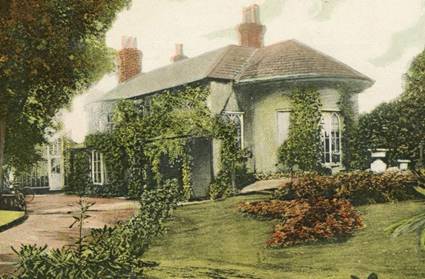
Chestnuts c1910, when Allan Gardner lived there. Photograph by Mr JH Venn.
He had a private income and was born at Portsea Island, Hampshire. In 1881 he was a pupil in a small private school in Portsea. We know he had come to Prestwood by 1899, because in that year the banns for his impending wedding were read there, although the marriage, to Agnes Elise Drew, took place in Southwark, London. Agnes had been born in West Ham to Richard Drew, a "board correspondent" (an affiliate or honorary member of a board of directors who may communicate in writing rather than attend meetings), and Elise, a Frenchwoman. The newly-weds kept two servants in 1901. He appeared on the Electoral Register from 1899 to 1931, although in the 1911 census they were residing in Rochford, Essex. At that time they already had seven children - Harold Frederick (1900), Georgina Mary (1903), Florrie Edith (1903), Lily Jessie (1904), Nance Withers (1905), George (1907) and Patria Withers (1909). It seems that Allan Gardner was a naval officer, as the first two births were with British Armed Forces in Malta and Devonport respectively. The next three were in London. He appears to have won a medal in the First World War. They participated socially in Prestwood, because they contributed to the funeral of farmer Daniel Bedford in 1907. I have not been able to trace when or where either Allan or Agnes died, nor who provided the foundation stone (above). (The district nurse in the 1960s was Sister Coulson and the sheltered housing development Coulson Court, Nairdwood Lane, was named after her. Information from Lance Free.)
This expansion across the parish was fuelled by the railway to Great Missenden, plus road improvements and the motor-car, finally eliminating the labour from getting up the hill from Missenden or Wycombe. One can hardly imagine a greater change in aspect in just those 50 years than that from the pony and trap or occasional bicycle slowly ascending the gravelled tracks to the general stores on the nascent High Street, where houses and small terraces were scattered among fields and orchards, to the lines of smooth tarmacadam, along which streaked (relatively speaking!), between continuous houses and shops, box-shaped black Austin 7s refuelling at Crossroads Garage.
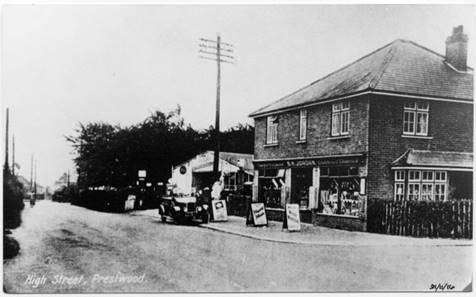
Shop of HJ Jordan (Crossroads Garage behind), High Street (corner of
Nairdwood Lane) c1916

Crossroads Garage in the 1950s
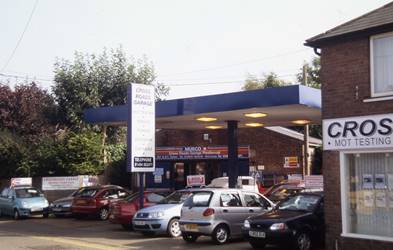
Crossroads Garage in 2006 (note that it had also taken over the former Jordan's shop to the right
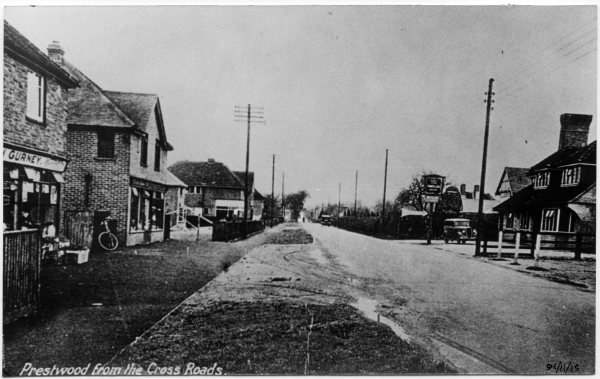
High Street, looking west from Nairdwood Lane corner, 1930s, Gurney's shop on left, Traveller's Rest (after being rebuilt in the 1920s) on right. The pub was demolished in 2014 and replaced by housing. Chiltern Garage Doors (no.37) now occupies Gurney's shop, while the shop beyond that (no.39) is now Scizzorz Handz (see below).

Same view in 2018.
Some things never change - the telegraph poles are still in the same positions!
As early as the 1920s the car was making its impact. The cycle repairers disappeared from Heath End and Sir Alfred Goodson at Peterley Manor was celebrated for his Rolls-Royce, when the first world war began, although motor traffic was still infrequent even in 1928, when one local resident remembers only about one car an hour bumping over the potholes of Wycombe Road (Holy Trinity Church, 1999, p17), while the bicycle, and indeed the horse and cart, continued as part of local traffic right up to, and through, the war.

Haven Stores (now
demolished, replaced by private house no.73 before 1955), Wycombe Road, with Austin
7, c1930
A film of a fancy dress carnival held on June 3rd 1922 reveals a strange mixture in the procession of pony and trap, horse and cart, bicycles, cars and even a motorcycle and sidecar. The procession went down Wycombe Road to Peterley, along there and back up Nairdwood Lane. The slow decline of horse-drawn traffic is illustrated by the fact that David Martin Nash worked as a wheelwright at Heath End up until the 1935, when he succeeded his father David as publican at the White Horse, and that William Peedle, succeeding his father Simeon, still worked as a carrier to Aylesbury until 1939.
Piped water had already been brought to Prestwood in 1902 (by the Rickmansworth Water Company), when the schoolhouse at the church was certainly equipped. Before then every cottage had access to a well or cistern, and water had to be carried by hand, sometimes in two buckets suspended on a yoke across the shoulders. Piped water, along with improvements to milk hygiene (see below) eventually reduced the incidence of disease and child deaths, but earlier in the century they were still an everyday tragedy. Emily Stevens, then aged 11, records in her diary that:
My little sister May was very ill during November 1910. …
April 8th 1911: Little May went to a nursing home at Amersham. …
May 19th: Little May died on a Friday at 10 minutes to 10 at night. Mother was there & [half a line scratched out]. She was buried at Prestwood Church on May 19th at 15 minutes to 4. We all went to the funeral. May was 2 years 19 days old.
(Over ten years later the Stevens family were still regularly visiting the grave of “little May”, as her niece Joyce Bennett (2004) recalls.
In March 1913 Emily also reports that school was closed for three weeks because of an outbreak of measles.) I am grateful to the late Rex Davis for showing me his mother’s diary, from which this extract and others below are taken.
World War I
The wider world had already intruded in an abrupt and particularly dramatic way during the first world war. Young Emily Stevens witnessed preparations in September 1913, when
The soldiers came to Great & Little Missenden … and some of us went to a service with thousands of soldiers. We saw an airship & an aeroplane while they were about here.
Unfortunately her diary ends abruptly with the outbreak of the war.
Another person recalled:
I can remember my father telling me about the First World War soldiers marching through Prestwood, and that they would come marching through in the morning and the columns of soldiers would continue into the evening. Soldiers were billeted in Prestwood and would spend their evenings in the Polecat, very often having one too many. Some of the soldiers were billeted with Granny Hildreth and, on their return from the Polecat one night, shot their rifles down the well which has remained cracked to this day. (Holy Trinity Church, 1999).
An aeroplane also crashed in the parish in 1916, which must have been a rare sight for parishioners when even the passage of a motor car was an event to be remembered.
Many families lost sons and husbands in the war. With the decline in woodland industries and loss of agricultural work at the beginning of the century, young men were often eager to enlist to escape unemployment. They did not know what they would face. The tragic losses in Prestwood are listed below.
R. Adams, sergeant in the Gloucestershire Regiment, died 1918; leaving a widow Dora Elizabeth at New Road, Great Kingshill.
Arthur Bob Bristow (1895), private in the Royal Fusiliers, died 1917. His mother Mrs J Bristow lived at Cross Roads, Prestwood.
William and Emma Chilton who lived in Bryants Bottom, lost two sons, Free (1884) in 1914 aboard HMS Aboukir in the navy, and Alfred John (1894) in 1917, a private in King's Own Yorkshire Light Infantry. Their father was a chair turner (see previous chapter).
Frederick Alfred Copeland (1891), private in the Royal Fusiliers, died 1917. His father Joseph, recently widowed, lived at Bordessa House, Great Kingshill.
Major HB Dresser, who had recently acquired Nanfans (and was to play a considerable part in the Prestwood community, see later in this chapter) lost his son Lieutenant Bruce William MC (1899) of the Royal Field Artillery in 1918.
Robert and Marion Gibbons of Prestwood (see previous chapter) lost two sons, Rupert (1882) and Frank (1892) on the same day, 21 October 1914, both privates in the Oxford and Bucks Light Infantry. Their father worked in the chair industry.
Stonecutter Harry Hailey, who lived in the row of cottages beside the Green Man, lost his son Ernest (1898) in 1917 at Ypres when he was a private in the Middlesex Regiment.
Arthur Janes, who had been a chair turner (see previous chapter), had become licensee at the Red Lion in Great Kingshill by 1916 when he learned of the death of his son Lance Corporal Albert Henry (1894) of the Oxford & Bucks Light Infantry, who had been active locally in cricket, football and rifle clubs. He also lost a brother Percy (1895) in the Machine Gun Corps in 1918, and two nephews George Albert (1893) and Frederick (1895) in 1916, the former a driver in the Royal Field Artillery. George's and Frederick's mother Bertha died, aged just 45, only a month after these two deaths, which must have overwhelmed her with grief, leaving her husband Albert, also a turner, without a wife as well as both sons.
The widow Elizabeth Langstone of Prestwood (see previous chapter) lost her married son Harry (1882), a driver in the Royal Engineers in 1917. A cousin of Harry's of the same age, son of the carter Thomas and his wife Ellen in Great Kingshill, private John Langston, also died in 1918 with the Manchester Regiment. He was married and living in Kent. Another cousin William (1891) who resided at Hazlemere died in 1917 as a Lance Corporal in the Canadian Infantry.
William Nash, farmer at Cockpit Hole (see previous chapter), lost his son Harry, a private in the Canadian Infantry, in 1916.
Simeon Peedle, the carrier and coal merchant (see previous chapter), lost his son Rupert (1893) at the age of 24 when he died at Passchendaele in 1917 as part of the Royal Berkshire Regiment. Rupert had married in 1915 and lived in Norman Cottages in Prestwood High Street. He left a widow Mabel and two daughters, Joan Mary born in 1915 and Margaret Elizabeth born in 1917. Joan, later Joan Axten, recalled how hard it was for single widows at that time, her mother having to supplement a small army allowance by taking in sewing.

Joan Axten, daughter of Rupert Peedle, in 2008 (from The Source HP16)
James and Elizabeth Phillips used to run the Royal Oak in Great Kingshill. Their son Albert G. (1883) was killed when a private in the Oxford & Bucks Light Infantry in 1917. He was married and lived in Great Kingshill, where he was a grocer in New Road. He was a bowler with the cricket club, a member of the football club, part of the Village Hall committee in charge of catering, and was an expert rose grower (Bucks Free Press, October 1917).
Private Albert G. Phillips died 17 July 1917
Edward and Minnie Redrup lived at 3, The Cottage, Prestwood. Edward worked as a hay binder (see previous chapter). They lost their son George Alfred (1899) in 1918, as a private in the Worcestershire Regiment.
Former stonecutter John Ridgley lived in Bryants Bottom (see previous chapter). He lost his son Charles Alfred (1883) in 1918, a gunner in the Royal Garrison Artillery. He was married and living in High Wycombe.
Former chair turner Thomas Saunders and his wife Lucy lived at Bryants Bottom and lost their son Ernest (1891) in 1917, a private in the Oxford & Bucks Light Infantry.
Free Smith, a stonecutter, had died young, leaving a widow Sarah who lived in Prestwood (see previous chapter). She lost her son Harold (1887) in 1917, when he was a private in the Grenadier Guards.
Gunner George Statham (1898) died in 1917 as a gunner in the Royal Field Artillery. He was the son of George Lilford and Charlotte Statham, who lived at Lilford Cottage, Prestwood.
Edward Timpson used to run The Polecat and later moved to Great Hampden and worked as a carpenter (see previous chapter). He and his wife Hester returned after 1900 to Great Kingshill. They were unfortunate enough to lose two sons when they were 21, William (1894) in 1915 at the battle of Loos (private in the Gloucestershire Regiment) and Edwin (1897) in 1918 (a corporal in the Canadian Infantry). At Loos the battalion was reduced from over a thousand to just 400 men, the rest gassed or shot.
In addition, the son of baker Herbert Groom of Ivycroft in Prestwood was seriously injured in France during the war. Lieutenant Hubert Stanley Groom (1890), who had been a schoolmaster, was with the Manchester Regiment. In a letter about the incident, it was written: Our men had advanced 400 yards beyond the front line and fell into a hotbed of Huns. They were charging with bayonets when Lieut Groom fell, shot by a machine gun through the right arm. On getting up and turning to leave the company, he got another shot [in the buttocks] ... Hubert Groom fortunately survived and lived until 1987.
A fascinating glimpse of life at the time of the war was given in a diary by Rupert Stevens (of the butcher family), quoted here with the permission of Mrs Faith Paul (née Davis).
" At the outbreak of the First World War, we had three shops in Wycombe. The White Hart Street shop, Desbro’ Road and corner of West End Street and Easton Street. ...
"All men of military age had to join the Home Guard and go to Priory Road Yard for Squad Drill. Sunday we had to take packed lunch and go to Didcot where we used to unload thousands of pick axes, shovels and wheelbarrows, or go on a route march round Penn or Tylers Green. Every three months we had to go before a Tribunal and my father would appeal and get Charlie and me off for another three months. The authorities checked up and found that Desbro’ Road was a small shop and not so much trade as White Hart Street. So Charlie was to be called up. I said that I was younger, fitter, and only had one child so I would go instead, while Charlie saw to the running of the shops. ...
"My father used to buy horses for the Army. They had to be about 16 hands, quiet, and about five years old. Once I went with him to Stokenchurch and saw a young horse. He asked the farmer if he could see his son ride it around the field, as he was afraid, so he got me to get up on it. The horse bucked and reared and ran out onto a stony road. I thought of Ethel at home and baby Doris, only a few days old. I was scared for my life and thought I should get my head split open.
"When I joined up I had to go to Cowley Barracks at Oxford. I was to go in the Infantry. I spoke up and said “Sir, I have two brothers with the Royal Field Artillery and I refer to the King’s Regulations which says brothers are to serve in the same part of the Services.” They had to put me in the Royal Field Artillery. On the Monday they gave me a railway ticket to Woolwich which is the HQ of the RFA. I thought I would like to spend the night at home so I went off next morning. Each day we had to march round and names and numbers were called out. My name was finally called out on Friday. Finally I was equipped with a uniform – which was just thrown at me. I couldn’t get my puttees right so I went and saw two High Wycombe men who were officers.
"While waiting to be called we had to dig a garden in Plumstead. Eventually I was sent to Abbey Park, High Wycombe, which was one of the HQs for The Royal Field Artillery. After two weeks it became an overseas camp and I was sent to Biscot Road, Luton for training. One day during a break I was with some other men and we were vaulting a horse when an officer came up to me and picked me for his team to go to India the next day. The next day an officer came out when we were on Parade and said I and five others were to report at once and go to Bath for a trade test as they were short of slaughtermen. One of our men had scabies so he was left behind.
"We were taken to an empty house where we slept on bare boards with our haversacks as pillows. While we were waiting we were marched up to the top of a hill where lots of the soldiers jumped over the wall of a gentleman’s garden. It was scandalous – they took tomatoes, strawberries and everything they could possibly eat! Finally we had our tests – a bullock each. We were watched by three men, one a civilian, one an Army officer and one a civilian expert slaughterman. When the Army Officer came up to me and tapped me on the shoulder he said “I can see you have done a lot of this.” ... I was sent straight off to South Shields where they did 100 bullocks a day to feed the troops in England. ... I managed to get a “Sleeping Out Pass” and I got Ethel and Doris to come and found three rooms. ...
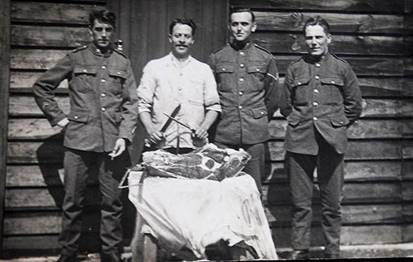
Rupert Stevens (in white butcher outfit)
"Later, I was taken to what was thought to be a modern abattoir which was at the back of a butcher’s shop. They did not kill the cattle humanely with a pole axe, but bashed their brains in with a hammer. I took the hammer away and killed the cattle humanely. We had to take the hides to North Shields and put them straight in a freezer. I told the man they would rot and ferment but he took no notice. Six months later I had the ordeal of unloading the freezer. With the fermenting, rotten wasted hides, the stench was beyond description. This job lasted six months then I was returned to Luton and equipped for France. We set sail early one morning, it was snowing hard. Ethel came to see me off with a packet of nightlights. When we got to the station at Luton some of the men went berserk, starting snow-balling, smashing up the station, breaking windows etc.
"Before we went to France we were on parade one morning when an officer found that a Welshman had a spoon in his putty and he choked him off. The Welshman turned round, hit him under the jaw and knocked him out. There was another sergeant major, so strict and unbearable that some of the men decided to waylay him. They knocked him over and frogmarched him to the river and threw him in.
"When we were on the boat we were chased by submarines and we wore our lifebelts at all times and were a very long time getting to France, with all the zigzagging. When we arrived at base, we were met by another Wycombe man, Wally Baker, and some I did not know. I was put into an Ammunition column so I again pointed out that I had two brothers in the Artillery. I was thankfully sent to the Royal Field Artillery where I joined up with my two brothers, Bert and Sid. We were all posted together with the 33rdDivision Head Quarters Staff.
"I was posted behind Ypres as a mounted dispatch rider. The gun line was several kilometres in front of Ypres. Their headquarters was in a dug-out at Square Farm (same name as our place at Prestwood). I had to take messages at all hours of the day or night. I often met men from High Wycombe. I met the manager from the International and the Home & Colonial Stores. One day, on the way up the Ammunition Column, a man called out to me “Hullo Stevens”. He was Gilbert Mead of West Wycombe. We had a quick chat and on the way back I found he had been killed. When I was demobbed I went and told his parents that I was the last High Wycombe man to see him alive. He was killed in under half an hour from when I left him. I knew Hell Fire Corner and Dicky Bush inside out.
"Things were so bad as we pushed the Germans back that we were not getting our rations through. We picked up dirty food and biscuits out of the mud and scraped off the mud. They went down as good as rump steak – we were so ravenous. We had to take our water with us as the Germans had poisoned the water. We were not getting rum rations through and, as I had a terrible cold, I told the Quartermaster that I must have a good issue of rum that night. I was more nervous of my bad cold and sleeping out rough than of all the shells. The QM said “I dare not”. I said “If you can’t, I shall knock it off, but if you can get me some you shall have a Bradbury”. I had one pound note sewn in my bodybelt. He said “Where is your mug?” I took it off my bandalier and bought a pint of neat rum. I gave a small drop to brother Sid. I said ”As soon as I have drunk this, throw my horse blanket over me”. I went into a dead sleep. They had the horses off the line twice because of the shelling and I didn’t hear a thing. They had to shake me, even lift me up and jump on me, to wake me up in the morning. Strange thing, I never had a headache and my cold was much better!
"We drove the Germans back in one village. The French women ran out as we were riding along on our horses and gave us wine and tea, they were so delighted. I actually saw French people dig up money they had hidden from the Germans in their gardens and fields. As we advanced through Mormal Forest we rode over our own dead soldiers.
"One night another soldier and I had to drive a G.S. Wagon to take seven gunners up in exchange for seven gunners in the front line. While waiting for the exchange a Bomber came over an killed the seven men in front of our eyes. Instead of bringing back seven gunners we brought back their seven bodies. The next day we had the great ordeal of sewing them up in horse blankets and they were all buried in one trench with twelve others. I remember so well those nineteen men all buried in a trench.
"I happened to be on the sector when a delegate came across at Messens. Ceasefire on a twenty mile section and we couldn’t understand it. Later we heard that at 11 o’clock that morning an armistice had been signed on a train just near us. I remember the soldiers nearly went mad, jumping for joy and throwing their caps in the air.
"After the Armistice was signed I had an injury to my eye. We had a wonderful American doctor who said “I think you have done well to come through all this. Go to the Casualty Station and you should be in Blighty in a couple of days.” This was at the time of the great flu epidemic and I was detailed to take the temperatures. Of course I caught the flu which developed into pneumonia. During that time 40 were carried out dead with flu. I wondered if I would be the next. I lived on brandy and port and was unconscious part of the time. When I came round the Matron said that I must have been a steady sort or the brandy and port would not have had that effect. They sent Ethel a telegram as they thought I was dying. Then they sent another to say “Getting better, returning to England”. We were sent off to a French station on our stretchers and lay there waiting for the train. It was bitterly cold and a gale was blowing. I could not imagine how I would arrive home alive. How I prayed to be spared.
"Eventually we got on to the hospital ship. I shall never forget they asked each one of us where we would like to go. I said London. This really cheered me up as Ethel and Doris were there with Ethel’s father and brother and the Bennetts. When we arrived in England we were put on a hospital train in three tiers. I was in the middle bunk, the poor man at the top was so bad he kept being sick on top of me. In fact, they had to pull up at Chelmsford and send him to hospital there. I then realised we were not going to London and we went to Bradford. We arrived in Bradford at midnight. Crowds were waiting for us to welcome us home. They were shouting and singing “Welcome Home Tommy”. They put packets of cigarettes and shilling pieces on our stretchers. We were taken to an old workhouse, now an army hospital. When I was finally put to bed some man called out and told we newcomers that it was a “hell of a place”, but to us, from the trenches, the flu and the journey home, it was like paradise.
"The Orderly looked at my case card and found out that I came from High Wycombe and said “We have an optician called Dairy from High Wycombe here”. He fetched Mr Dairy who sent a telegram to Ethel and she and Doris came up the next day. Mr Dairy found them lodgings. I shall never forget my dear wife and child arriving. Doris pulling a little horse and cart. I felt overjoyed – I hadn’t seen them for well over a year. This hospital was a marvellous place. Ladies brought us jellies and played cards with us. I felt we were treated like Lords. Ethel’s brother, Frank had already been here with an ankle injury and his wife Edie, my sister, had worked here and helped to nurse him. Ethel and Doris used to visit me every day and Doris used to go round to the men in the ward with her horse and cart pretending to sell meat. One of them gave her a book. Almost all of these men in the ward died. I was allowed home for Christmas and released from the Army in January 1919 on account of having been in hospital for over a month. I went in to the Army A1 and came out C3. When asked if I wanted a pension I said “All I wanted was to get shot of all of them”.
Between the Wars
Until 1925, when the electric grid was first brought to Prestwood and paraffin lamps (and candles) began to be phased out (it would be another ten years before this happened in Great Kingshill), the only homes with electricity had been those who could afford their own generators, such as Peterley Manor:
The small building behind the gatehouse once housed a generator to provide electricity to the Manor House. Early, very thick glass accumulators, stored on shelves, were charged during the daytime and electricity passed to the house via a large overhead cable at night, so that the occupants remained undisturbed by the noise of the generator in the quiet hours. (Coulon, 2000)
HolyTrinity Church had electric lights fitted in 1930. Until then it had relied solely on candles and oil lamps, the smoke of which had so damaged the interior in fifty years that major renovation had been needed in the 1890s (Keen 1999a). Gas also became available in 1936, and the era of “domestic appliances” arrived to alleviate the time-consuming domestic chores that had been the reason until then for the large coteries of domestic servants employed by the wealthy families.
By 1939, then, Prestwood was a very different place in which to live (although it would be another ten years before the last of the main services - sewers - came to the village). It was also much more like other places in England than it had been in 1900. No longer was it the same rural backwater, but now it shared many of the facilities of the small town, and life’s horizons were beginning to expand.
Woodland industries
Despite all the changes, the greater part of the land in the parish was still agricultural or woodland. The demand for chair-legs from the beechwoods, however, was already in decline and rather than gradual continuous harvesting, woodland management was beginning to move into wholesale clearance of larger trees for other markets, often replaced by plantations of foreign evergreens, mostly larch. An example is provided by the sale of timber from Atkins Wood in 1905 by trustees of Miss Ann Daniels (who had purchased much land in this area around 1850 although not living locally, see Chapter 7). The sale of 100 loads of beech timber along with "lop and top" (the complete crop of this tree in the wood) fetched at auction £114-5s-4d, and the auctioneers Vernon & Son of High Wycombe wrote in their letter to the trustees (Messrs. Druces & Attlee) "Considering the somewhat depressed state of the chair trade we consider the prices obtained to be quite satisfactory". (It should be noted that in 1841, according to a bill of sale by William Grover to George Mason and James Gurney, the beech timber in the wood was valued at £456-15s-5d, so that the drop in value is very evident.) The wood was replanted to a mix of beech, larch and Sitka spruce, much of which was again harvested a hundred years later in 2013.
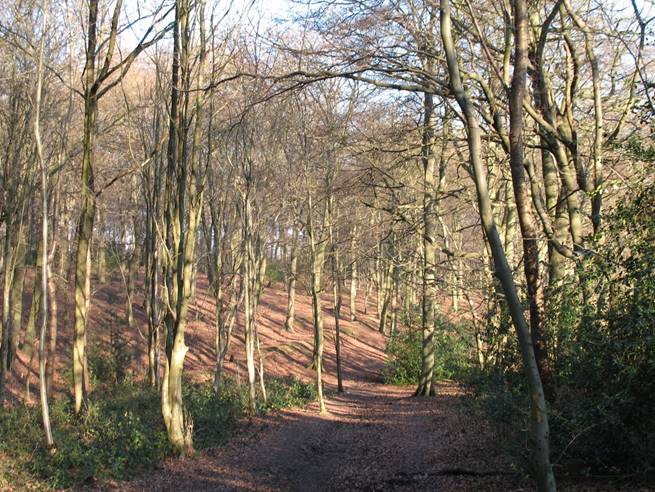
Atkins Wood in 2007 before the second clearance
There was still a timber yard in 1950 (Jennings on the High Street) and a wood-turner’s at Peter’s Close. Bodgers worked in Prestwood through the 1930s (such as Tom Gomme, Owen Smith), but the trade survived after the war only in even more rural areas such as Hampden and Speen.
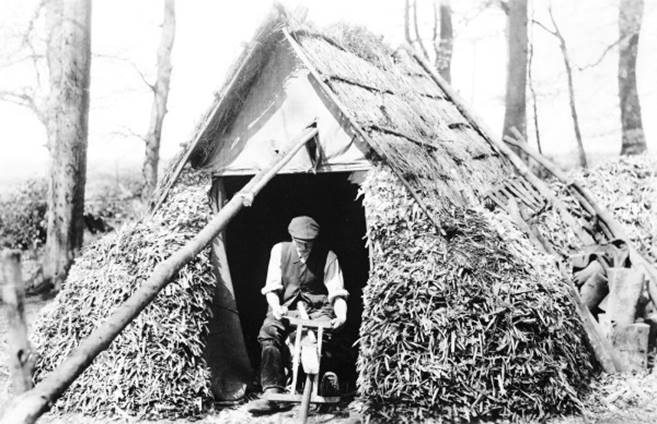
(Above and below) Bodger TH Gomme working at his hut in Lodge Wood 1929; above with a shave-horse, below roughly shaping a chair-leg with a hand-axe
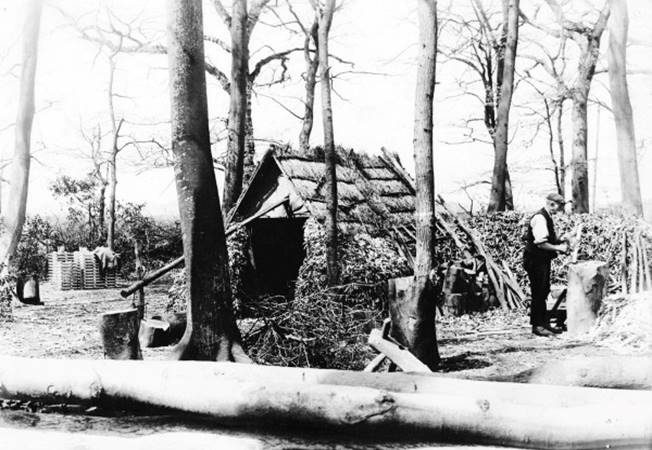
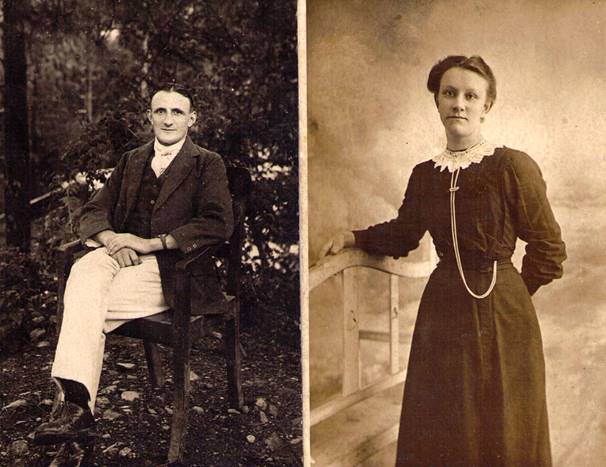
One of the last bodgers, Owen Smith, son of a Denner Hill stonecutter (see last chapter) and his wife on their wedding day 1920. He looked after his widowed mother Emma until she died in 1914 at the age of 75.
Many of the beechwoods planted in early Victorian times nevertheless did survive and were now maturing to provide the scenery for which the Chilterns has become particularly renowned – although these swathes of fresh green in spring, cool shade in summer and deep gold in autumn that attracted the tourist were no more indigenous than the visitors themselves! In 1938 The Times was featuring the Chilterns as a site for a motor tour (itself a sign of the changed times), enthusing over “those matchless woods in such beauty in spring” and “the hundred hued veil they spread over the shoulders of the hills in the distance” (Prioleau 1938):
We went to Hampden Row and Hampden itself and Prestwood, all among the waiting beeches (they are finer just here than anywhere else), and all of it was worth while. This is a very pleasant part of the world at all times of the year: it should be at its best when a week’s rain has restored their natural light and colour to the tall trees.
Orchards
The last writer would appear to have come just too soon to see the flowering of the cherry orchards (“ from a distance they appeared like hills of snow; the twigs and blossom from one tree touched that of the next ” remembers a local resident quoted in Holy Trinity Church, 1999), or no doubt he would have enthused over these as well. Certainly tours were organised in charabancs from as far away as London to see the cherries flowering. Prestwood cherries were sufficiently well-known for Alfred Rothschild to nominate them as his choice for making cherry brandy, and there was a specific local variety known as the Prestwood (or Little) Black.
The orchards ... supplied the Leicester and London markets, when it was still possible to send fresh freight from Great Missenden station. Cherries in wooden crates sealed with cardboard lids were delivered to the station by horse and cart. … cherry picking coincided with the annual two week shut down of the Wycombe furniture factories, and many townspeople spent their ‘summer holiday’ working in the orchards . (Davis 2004)
Factory workers came at this time from further afield, too, the Midlands and London. The Prestwood Black was a "maz(z)ard" (apparently derived from the Old French word masere, although this referred to maple), a descendant of the ordinary wild cherry. On its own it produced small dark fruit that no longer suit the demands of modern supermarket. Mazzards were also used, however, as a vigorous stock on which to graft cultivated varieties. As well as Prestwood Blacks, orchards at Hampden Farm and near Prestwood Lodge also stocked another local variety “Nimble Tailor” or "Nimble Dick". The latest to fruit were the Merries (virtually the same as the wild cherry, from the French word merise), which included Prestwood Black above (also known as "Caroon"), saved for making local specialities like cherry pie (see Holy Trinity Church, 1999, p.23 for a local recipe for Bucks Cherry Turnover). A range of varieties were grown, each with different characters for different purposes, and many of these are endangered today in the age of mass production for the supermarkets. Those with particularly local associations included:
Alba Heart: black-skinned with dark flesh.
August Heart: large black juicy fruit with deep red flesh.
Bedford Prolific: another with shiny dark fruit.
Bigarreau.
Black Eagle: the only known specimen of this tree was discovered by George Lewis, surviving from a former orchard in the garden of Morris Randall in Prestwood. Cuttings were taken and propagated by Bernwode Plants. It has large sweet black fruit.
Black Heart.
Early Rivers: a particularly juicy variety.
Frogmore.
Goblin.
Lester: almost black with dark red flesh.
Napoleon.
Nimble Dick.
Prestwood Black: like the Black Eagle, this was discovered by George Lewis growing in a number of Prestwood gardens created on the site of former orchards, including that of Morris Randall. One surviving tree can still be seen on top of Denner Hill at Rickyard Cottage. This was probably the commonest variety grown locally, although not well-known more generally. It is a black dessert cherry.
Red Heart or Ronald’s Heart: large and heart-shaped, blackish with pale stripes and dark red flesh.
Strang Loggie: originally from the Channel Isles, very large with dark red skin and flesh.
White Heart: a large heart-shaped cherry with creamy-white skin turning mottled red on the sunny side and pale yellow flesh.
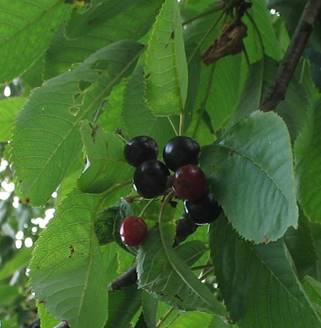
Nimble Dick cherries
As the fruit formed it was necessary to keep birds off, so that boys were employed for a few pence from dawn to dusk to bang corrugated iron sheets with large sticks, which must rather have spoiled the peacefulness of Prestwood at that time. There were not many wood pigeons around in the early C20th, as they were regularly shot, both as a source of food and to prevent them becoming a nuisance. Picking cherries involved special ladders (see Chapter 9). The fruit was collected in round wicker baskets with a concave base for stacking known as "sieves", capable of holding 24lbs of cherries. They were covered with paper and hazel sticks to prevent damage to the fruit. The end of picking was celebrated in local pubs with cherry pie suppers and pie eating contests.

Cherry orchards in flower alongside Heath End Road, Great Kingshill 1935. [Photo Ronald Goodearl.]
In the early C20th orchards existed both sides of Prestwood High Street, stretching north as far as the Kiln Common cottages and south along the Wycombe Road, most of this area now entirely covered with housing. A large orchard was planted to the north of Dennerhill Farm and lasted until about the 1960s. Although cherries, peculiarly suited to the soil here, were the mainstay, apples, pears, plums, damsons and cob-nuts were also cultivated, the latter often planted in the border hedgerows because they were not suitable as standard trees. Particular local varieties included:
Apples
Bazeley (“Best of The Lee”): which originated at The Lee, a small village on the hills across the Misbourne valley, and grown by most farms and cottages in this area in the C19th for making mincemeat, keeping its texture when cooked. It is a green cooker, turning yellow, that can also be used as an eater after storing.
Long Reinette (or Long Runnit): another variety associated with The Lee and local farms. It was a dessert apple stored in straw in barns to bring out at Christmas. The green skin is more or less streaked red and the shape is somewhat elongated, hence the name. When a new house was built on Pipers Lane where a remnant orchard apple tree stood it was called Long Runnets, a local version of the name of this variety.
Plums
Aylesbury Prune: a smallish blue-black dessert plum which grows on trees with rough twisted bark.
Cherry Plum: whose small round fruits are variously red, purple or golden-yellow, and whose flowers appear before any of the other fruit trees;
(Information on varieties of orchard fruit was derived from local informants and the catalogue of Bernwode Plants nursery.)
Cattle or sheep were routinely grazed in these orchards, helping to control the grass around the trees and making double use of the land. This practice is continued today in the orchard at Collings Hanger Farm.
Farming
The prosperity of farming reached a peak around 1900, when there was still a good mix of pasture and arable in Prestwood. Land under crops, however, steadily declined in extent until the second world war. Cheap wheat was coming in from America and the rise of motorised transport reduced the demand for oats and roots to feed farm horses. At the same time better-paid industrial jobs in the towns were becoming accessible to farm labourers and the cost of keeping them on the farms was increasing, again hitting most the labour-intensive arable farms. The hilly terrain and relatively infertile soil also prevented recourse to the huge fields of potatoes and sugar beet that at this time came to dominate East Anglia and the Midlands. Cropland was therefore turned to other uses, as pastureland, hayfields (especially Collings Hanger and Nanfan Farms) or to raise pigs, chickens, turkeys and game-birds.
Meanwhile New Zealand wool and lamb imports began to knock the bottom out of sheep-rearing, and most grassland was now used to raise dairy or beef cattle. The completion of the railway network, enabling the speedy transportation of fresh milk, had turned dairying into a much larger-scale activity than it was in the C19th, when herds were no larger than needed for purely local consumption of milk, butter and cheese. New legislation on hygiene also enabled better quality, safer milk to be produced, itself enlarging its potential market. TB was eventually eradicated by pasteurisation.
Although the Chilterns were not necessarily the same as other parts of Buckinghamshire, the figures for the area under different kinds of agriculture in the county in 1913 are still instructive. At that time, 61% of land was permanent grassland, 30% arable, 8% woodland, and less than 1% heathland. The clearance of heathland and the decline in arable are clear. The main crop at this time was wheat, closely followed by oats, with barley some way behind, and smaller amounts of beans, peas, potatoes, turnips, mangolds, and fruit. Druce (1926) was scathing about the large bare chalk fields with "scanty corn" or "flinty turnip fields"!
Wren Davis (1900) took over the farm at Collings Hanger on 25 October 1923. He was the son of Arthur Davis on Denner Hill. Wren took his distinctive name from the maiden name of his great grandmother and this was the name everyone used, although he had been christened Arthur Wren). By this time his father was a prominent local figure as a county alderman and magistrate, as he was to remain for the whole period between the two world wars, owning not only this land, but also Stonygreen Farm which had been sold by Mr E Stanford in 1910. The catalogue of the stock sale on this occasion (my thanks to Virginia Deradour for showing me this) gives an insight into the nature of a typical small mixed farm at the time. Animals comprised 13 cows, 34 lambs, an 18-month sow with 6 pigs, a horse and pony (in foal), 100 fowls, 6 turkeys, and 3 guinea fowls. The cows were of a variety of breeds – a shorthorn, a red cow, two cross-bred cows, and a brindle heifer all with calf, plus a pure-bred Jersey heifer, two shorthorn heifers, and four red steers. The main crop was hay, of which there were three 10-ton ricks for sale at £6 each. There were also two ricks of “White Tartar” oats (£7 together), and one of wheat and straw (30 shillings). Among sundry equipment to be disposed of, there was a brooder for chickens, a portable hen house, rick poles and pulleys, water barrel on iron wheels, a Ransome iron plough (28 shillings), a Howard iron plough, a Ransome ridge plough, a mangel drill (for planting mangel-wurzles as cattle feed), a Woods iron horse rake (30 shillings), a McCormick mowing-machine (16 shillings), a McCormick binder, a Bentall two-knife chaff-cutter (£1), a cake crusher and a winnowing machine (29 shillings and sixpence). Dairy utensils and a churn indicate that a small amount of milk was also produced. Arthur Davis himself was now raising wheat, fruit, game-birds, cattle and pigs on Denner Hill, assisted by his son Dudley. His son Richard still lives there today. The slopes are so steep that
before tractor power, only one man on the farm had the skills to turn a team of horses on the banks. Even now, tractors must be driven down the steepest slopes and not across to avoid tipping over (Davis 2004).
By the 1930s, however, Dudley Davis was using steam traction engines and threshing machines, contracting these out for extra income to other local farms.

Old Howard Bedford iron plough (on display at Peterley Manor Farm)
Wren meanwhile had to wait for the previous tenants, Arthur Grover and his wife, to build themselves a new house just to the north of Collings Hanger Farm, before he was able to marry and move into the farmhouse in 1925. The farm stock had been auctioned off in 1920 and reflected a very different business from Stony Green, with a focus on pigs and poultry. The pigs comprised 8 black and 7 white “porkets” (young pigs fed for pork production, now usually called porkers). There were 65 hens, a black Minorca cock and a pullet, 14 white Wyandotte hens, and 35 Wyandotte chickens. Finally there were three horses and a rabbit hutch (but no rabbit!). There had been cows, which must have been disposed of earlier, for the equipment for sale included milking equipment, a calf manger, rock salt and a cattle sling and pulley. There was also charlock seed, presumably sown as cattle feed. The main crops were, like Stony Green, hay and corn. These were cultivated with the help of a Ransome iron plough, a Pratt iron plough, a Ransome one-way plough, horse rake, winnowing machine, a Hornsby self-binder, a McCormick mowing machine, and a Knapp corn drill. Horses were used to draw the ploughs etc, and also for transport, with 3 farm carts, a spring market cart (with ladder, double seats and lamps), and a governess car (a light 2-wheeled chaise with side-seats).
Wren’s bride, Emily Rose (1900), was a daughter of Cornelius and Mary Ellen Stevens (see previous chapter and below), so uniting the two main farming dynasties in Prestwood. Wren and his new wife had taken over a mixed farm and continued to rear pigs and produce crops. Arable production was based on a five-year rotation: wheat one year, oats the next, roots (mangolds and swedes) and kale in the third year, barley in the fourth year, the barley being undersown with grass as a basis for the final fallow year of clover. The resting year helped regenerate the soil and the clover fixed nitrogen to provide a nutritious soil for the next wheat crop, which began the cycle over again. Hay was produced as winter feed, the ricks being thatched in the traditional way (see below on Lisley’s Farm). There was a cherry orchard beside the farm and another across the road behind the since-demolished Collings Hanger Cottage.
Within a couple of years, however, Wren purchased two cows to begin what was to become a successful high-quality dairy business. Milking was carried out by hand until 1944. Traditionally local milk was carried around in large cans, customers collecting it in their own jugs. Wren Davis was the first in the area to introduce milk bottles, washed at this time in the kitchen sink. He was also one of the first five dairy farmers in the country to be licensed to produce Grade A milk. His first delivery in September was to two customers, charging 3d a pint (approximately 1p in current coinage), but, with an emphasis on modern hygiene, the business soon snowballed from there. His son Rex remembers making deliveries of milk and ice-cream on a solid-tyred bicycle, carriers back and front, in the thirties. In 1930 Wren Davis won third prize in the All England Inter-County Competition for clean milk, already had a sizable herd, and employed a good number of dairymen.
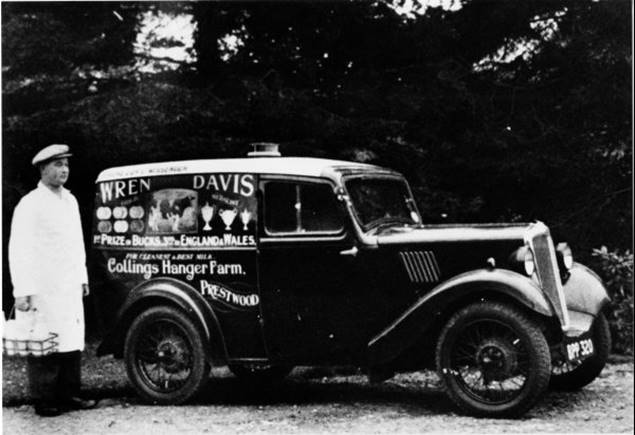
Milkman for Wren Davis, late 1930s
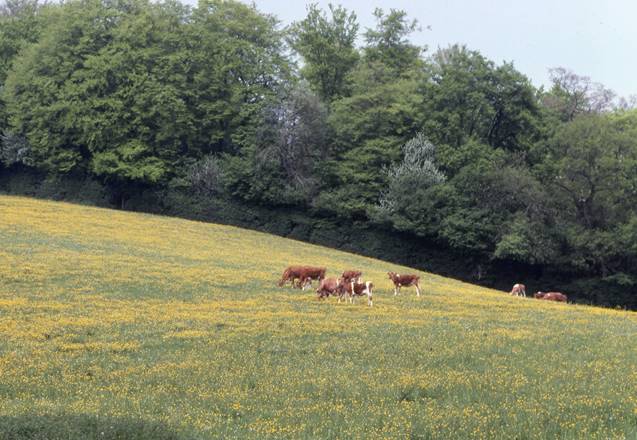
Jersey cows in Clay Markings field belonging to Wren Davis farm 2001
Wren and Emily had two daughters, Faith and June, and two sons, David and Rex. When he died at the age of 67, the church at Great Hampden was decorated for the funeral with wild flowers. The farm was left to his sons Rex and David and it is David's daughter Virginia who runs the farm to this day.
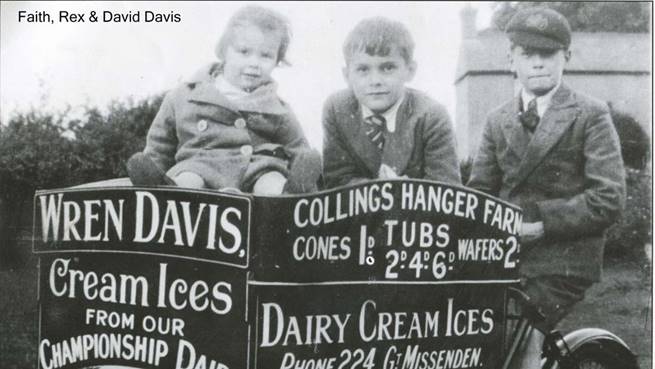
Rex Davis died in 2009 at the age of 80. In her funeral address Virginia Deradour remembered that he was seriously ill at the age of 9 with meningitis, missing a year's schooling, although he still managed to pass for the Royal Grammar School in High Wycombe and became head boy. He never married but engaged in community affairs, supporting several charities and purchasing an organ for Great Hampden Church (where he was a bell-ringer). 300 people attended the funeral and the coffin was pulled by his pet donkey Neddy.
David Wren Davis (1926) very early became an advocate for steam traction engines, as used on Denner Hill, even riding back from his wedding reception with his wife Jean on one in 1957. The engines were used for ploughing (one at each side of a field would draw a plough across between them), and many other jobs such as clearing trees. They were often hired out to other farmers. and his enthusiasm lasted to the present day, long past the machines' practical usefulness, superseded by the petrol-driven tractor. His son drives steam engines as a hobby to this day and the farm every year hosts a nationally-known Steam Fair, attracting machines driven from fellow-enthusiasts from far afield.
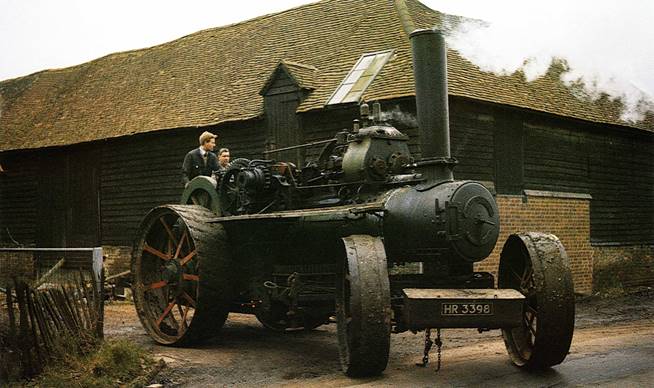
Steam traction engine leaving Collings Hanger Farm 1999 (photo by Rex Davis)
The Stevens family had started a new farm, Square Farm, a former cottage at the north-west corner of Prestwood Common, around 1880. Cornelius Stevens had taken this over in 1895, breeding pigs, beef cattle and shire horses, and maintaining an orchard. Cornelius Stevens' daughter Emily described in her diary in 1910 how
At the flower show at Prestwood, Father had three prizes for his horses, a first for Prince Edward and another first for Peggy; also a second prize for Albert’s horse; Sidney [one of her brothers] had the second prize for his wood-work which he did at school. I put a pinafore and wild-flowers in, but did not get a prize. ( She subsequently describes further prizes for Prince Edward and Peggy at Tring, Halton and Aylesbury shows.)
Cornelius later built a bacon-curing factory and opened a butcher’s shop. His wife Mary was a local girl. From 1910 onwards he lived at a large house, The Limes (since demolished) in Wycombe Road, on the site where Hildreths Garden Centre now stands. (The large oak tree that stood at the front of the house survives to this day as one of the largest and oldest trees in the parish.)
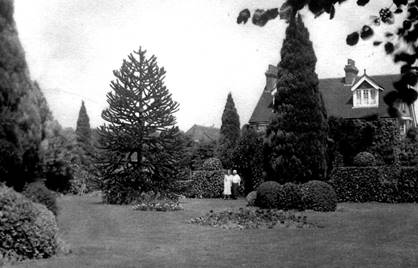
The Limes from the garden
His mother had died in 1903 and his father got remarried in 1905 to the widow Ellen Ives, but he died ten years later on 30 March 1915, his executors being Ellen and Cornelius. Cornelius's family of 12 children were then all grown up and dispersed, but family solidarity was still strong, and most of them would still attend Holy Trinity church regularly, where they would all sit together and Cornelius would hand round sweets to the grandchildren (Bennett, 2004). The meat business was highly successful. All seven of his sons became butchers, with shops in towns over a wide region of the Thames Valley area. After Cornelius died in 1932, his four sons Arthur, Alfred (living at Springfield just outside the southern tip of the parish, and who had married Alice Clarke of the Moat Farm family), Charlie, and Rupert took over the factory as C. Stevens & Sons, enlarging its scope to manufacture pork pies, this venture becoming a major employer in Prestwood for thirty years. They also set up a branch in High Wycombe (White Hart Street).
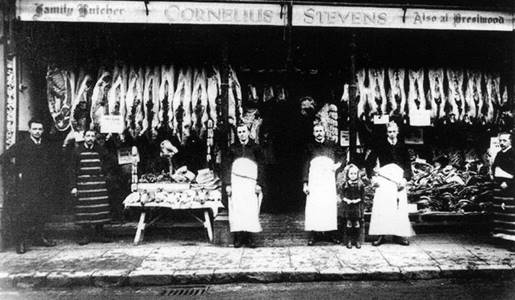
High Wycombe branch of Stevens butchers. Rupert Stevens is second from right.
When the Stevens factory was closed in the 1960s, a field to the east of the factory was used for ‘blood pits’ – deep well-like shafts, 30 or 40 feet down, for disposal of offal. The field was later used as the playing-fields for Clare Road school (built 1966) and the pits had to be capped with concrete because the ground above kept subsiding into them. A grassy dell between Collings Hanger Farm and Prestwood Lodge was similarly used. When the Lovells estate was built across the land this area had to be left as open grass because it was unsafe to erect houses on it. It is now known as Greenside (Doel 2000).
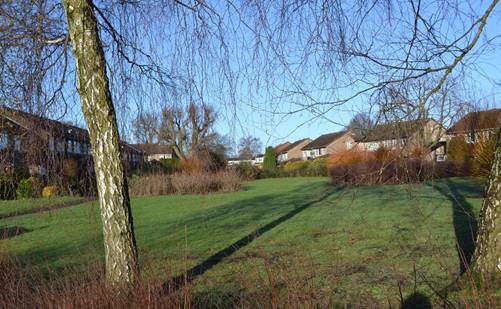
Greenside 2014
Pheasant-rearing had started in Prestwood towards the end of the C19th and became particularly prominent through the first half of the C20th. The Davis family on Denner Hill raised both pheasants and ducks. Apart from them, the Eltringham brothers (of whom Hugh Cyril lived in Prestwood, the other in Great Missenden) started up a major business Gaybirds Pheasant Farm on Moat Lane before the First World War, employing over a dozen men. They produced eggs and chicks for shoots all over the country. It was still operating in 1955 but seems to have ceased somewhere around the 1960s. H. Cyril Eltringham published a book " Pheasant Rearing: practical management and modern methods of rearing as practised on the Gaybird pheasant farm " in 1955. He also played tennis at Wimbledon between 1913 and 1922 and was a member of the Royal Flying Corps in the Second World War. He was on the Shooting Advisory Committee of the British Field Sports Society 1960-61.
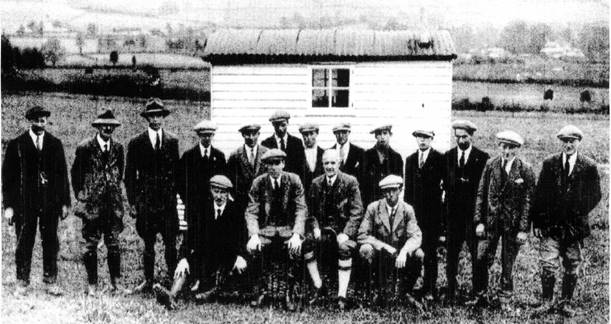
Gaybirds Pheasant Farm c1912.
Back row: Ernest Tilbury, Bert Beeson, John Wixon, ?, Cyril Groom, Tom Wixon, John Ward, Clem Groom, ?, Alf Field, Dick Wells, George Clarke, ?.
Front: ?, Cyril Eltringham, Mr Hunting, Mr Driscol
Herbert Groom , eldest son of Solomon Groom who had started the brickyard along Honor End Lane, had been a baker, but in 1915 he took up horticulture and breeding poultry. He exhibited his own variety of Wyandotte fowls ("Groom's strain") and won many prizes. He set up the Prestwood Horticultural Society and took an active role in village affairs, being a manager of the Moat Lane school, a trustee of Prestwood Village Hall, a parish councillor and a special constable. Central to his life, however, was his church, the Baptist Chapel, where he played a central role like members of his family before him. He died in 1936, aged 76.
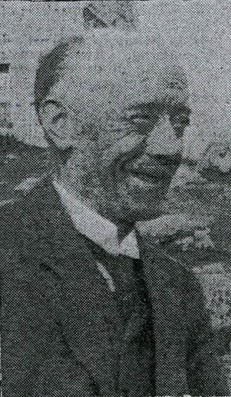
Herbert Groom
Pedigree pigs were being bred at Cherry Tree Farm by Ian Purdie from 1924 until the war. He died in 1943 when a lieutenant in the RAF (from natural causes). He had been a judge of pig breeds at Smithfields and secretary of the Princes Risborough Farmer's Hunt Ball.
The small Hampden Farm on Greenlands Lane was bought in 1919 by the builder Mr Parker. It produced and delivered milk, and fattened pigs for the Stevens factory.
The Priests took over Ninneywood Farm about 1935 to produce beef cattle. Their son John owns the farm to this day. His mother was another daughter of the Stevens family. The Priests had farmed to the south of Prestwood for generations. In 1851, for instance, a John Priest, then aged 31, occupied a 32-acre farm at Little Kingshill, very close to Prestwood. John Priest's father was a tenant at Ninneywood at first, but was able to buy it in the 1950s. John Priest relates their history:
" They built up a small herd of Guernsey cows and sold the milk to Wren Davis. In the 1960’s I started keeping pigs. I kept Wessex Saddlebacks and crossed them with Landrace and Large White. I used to keep them outdoors where they farrowed in huts and to start with I sold them as weaners at eight weeks old. In later years I had a farrowing house built and fattened them up to pork weight.
In the mid 1970’s my father gave up the milking herd, and by the 1980’s as the profit went out of pigs I decided to give them up and start a single suckled beef herd. We still have the beef herd, Charolais and Limousin crosses. The calves remain with their mothers until they are weaned at nine months old. When they reach 18 months we sell them to another farmer to fatten. We hire a Limousin bull from June to September and our calvings start in the following spring. All the food for the cattle is home grown , approximately 1000 small bales of hay and 200 large round bales of silage for the winter. The cattle remain outside all the year round but have a large barn to go under in the bad weather.
The farm is about 50 acres, including a small section of woodland. We don’t use any sprays and very little fertiliser. The fields are divided by thick hedges and provide cover for the diverse wildlife including badgers, foxes and deer. We have two ponds on the farm attracting moorhens, dragonflies and grass snakes. Ann keeps chickens, as free range as the fox will allow, enough to provide us and our friends with eggs.
It has always been a job to make much money on a small farm and even at the present time the government is encouraging farmers to diversify, so back in the early 1970’s we started a photographic business. We are still running this business and trade under the name of J. P. Photography. Nowadays my wife Ann does most of the photographic work, which consists mainly of press, public relations and portraits. You can see examples of our photographs on our web site – www.jpphotography.co.uk.
The large farm at Andlows, originally owned by the Honnor family of Great Missenden (Missenden Abbey Estate), was worked by the bailiff Theophilus Beeson on behalf of Major Samuel Day after the first world war, and by Mr Beeson later in the twenties and thirties.
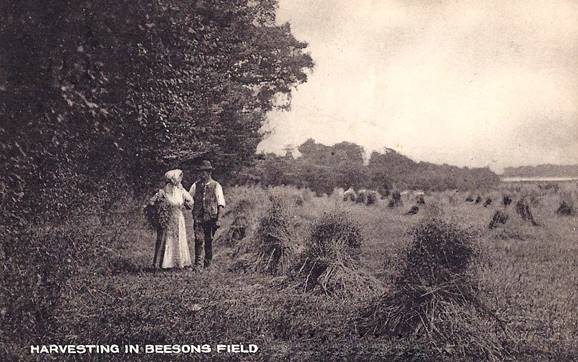
This appears to be Little Salmons, the field behind Andlows Farm. Taken in 1921 this photograph shows the hay-stooks but begs many questions, such as who were the couple and the purpose of collecting the leafy twigs the woman has in her basket?
The farm originally extended to the other side of Angling Spring Wood (another part of the Honnor domain), but the two fields there were sold off to the Readings of Town End Farm in Great Missenden in 1938. The main ride through the wood had been a route for farm carts between the two parts of the farm. The main farm was rented from 1939 by Joseph Edward Garner, who had been born in 1901 in Aylesbury.
Farm labour was eased in the 1930s by further mechanisation. As well as on Denner Hill and at Collings Hanger Farm, steam engines were in use at Hotley Bottom Farm by Rupert Taylor, who also hired them out to others. On what arable fields remained, declines in profits were also being alleviated nationally by the greater use of artificial fertilisers and weed-killers, which were becoming more available as by-products of the metallurgical, gas and chemical industries. Grassland was also being improved to increase the proportion of the more nutritious grasses and thus enhance milk yields and the growth-rates of cattle. Both started to have impacts on the distribution of wild flowers and grasses, exacerbating the effect of the withdrawal of sheep-grazing. At the same time, rolling and autumn cultivation were introduced to control insect pests in the soil, exposing them to birds like rooks and lapwings, who thereby benefited.
Before the second world war these changes were slow to occur and most local farmers cherished traditional ways. Mr Bellingham of Hatches Farm was still walking flocks of sheep along the old road to Aylesbury (according to one of the recollections in Holy Trinity Church 1999). Hillcrest Dairy operated from Hatches Farm through the second world war and delivered locally using a Morris 8 van. Massingham (1940) describes how the old craftsmanship was still valued at "Lisley’s Farm" (Sladmore), Great Kingshill, where he saw thatched hayricks that he regarded as masterpieces of the art:
… all the rounded ones have each a “dolly” at the apex, a stylized crown of plaited straw surmounted by a tuft of wheat ears and coiled at the base with a woven straw-band which, as Mr. Lisley told me himself, is 30 feet long.
Similar ricks were built elsewhere in the parish, too, as is shown in a photograph of Collings Hanger Farm about 1910. For thatching they were still using the old ladders that had curving side-pieces, broad at the base and narrow towards the top, that were also used for cherry-picking.
Other local industries
Economic opportunities in Prestwood outside farming and forestry continued to be scarce. Samuel Howard, still using a horse to turn the pug mill, continued his brickyard, living in the house called Kiln Lodge beside it. He supplied bricks for the Queensway Mersey Tunnel in 1934. (Some, however, bemoaned the "Chilterns brickfields which mar the scene and pollute the air" - Druce 1926.) At the beginning of the second world war Samuel Howard was forced to cease operation because the fires of the brick-kilns would have provided a guide to enemy aeroplanes seeking out Chequers. His son John re-opened the yard after the war in 1949, but it failed to thrive and closed in the 1950s. John since moved to Portsmouth.
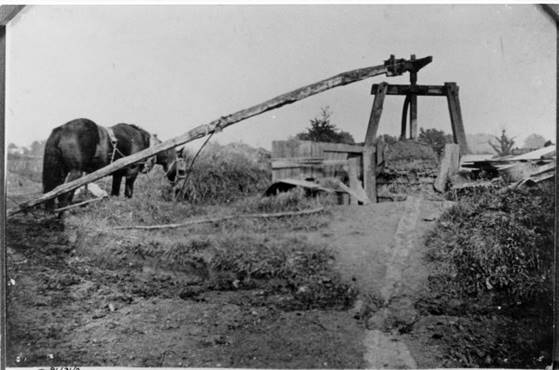
Samuel Howard's brickyard, Honor End Lane, c1927. Horse harnessed
to the beam of a pugmill, which worked the clay prior to being place in the
moulds to make bricks.

Fancy brickwork and ironwork gate to Kiln Lodge 2006. Photo by Val Marshall.
The working of Denner Hill stone was abandoned at some time in the 1920s.
Members of the Hildreth family were still working as blacksmiths along Wycombe Road and at Blacksmith Lane in the 1950s, and there was another blacksmith below Hotley Bottom on the Rignall Road (he also sold drinks in the 1930s), but this trade would survive very little longer. (The forge at Hotley Bottom, however, still produces decorative ironwork to this day.)
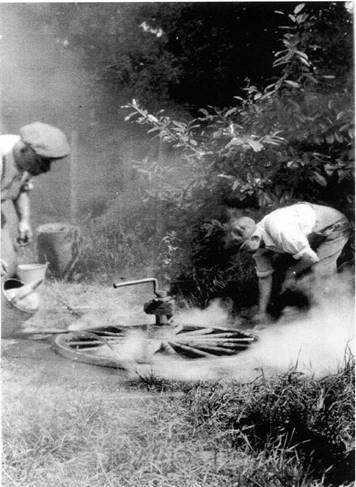
Hildreth's Forge c1901: fixing a hot steel rim on a cartwheel to shrink into place on cooling
There were builders’ yards attached to the Green Man (Percy Parsons, son of George Parsons who ran the Green Man), by what is now Hildreth Road (Brown and Clark's; H.J.Biggs Haulage Contractors' yard) and at Hampden Farm in Greenlands Lane (Geary's), and Jenny's timber yard at Peter's Close (employing the last of the bodgers). The largest employer in Great Kingshill was George Biggs and Sons, based at Hoppers Farm, started in the 1880s (see previous chapter). This firm employed many local young men as bricklayers and labourers. George himself died in 1908 and his eldest son George Henry (1865), a carpenter and joiner, took over the firm while his brother Leonard (1870) ran the farm. The farm was sold off before 1920 (it eventually became a turkey farm in 1953) and the builder's yard moved to a large site nearby with offices and a house called The Glebe (built 1919), where George Henry lived. Seven semi-detached houses were built by Heath End Road, next to Old Fox Cottage, for its employees. (Coleman, 2014, records that this created two rival communities of building workers in Heath End Road and woodworkers around New Road. This is ironic because previously, in the heyday of furniture industry in the prior century, Heath End was dominated by timber mill there and woodworkers' families.) The firm was large enough to organise annual works outings, and it developed a wide-ranging reputation for solid square serviceable, if architecturally unexciting, buildings, working as far afield as High Wycombe, Watford, Slough and, after the war, London Docklands. George Henry Biggs died in 1944 and his eldest son Ernest George took over the Glebe and ran the firm with his brother Frank, who then was living in High Wycombe. Many others of the founder George Biggs' family were also involved in the business. As Ernest and Frank approached retirement the yard was sold in about 1963 for the Oak View housing estate, for what was apparently a princely sum, as the estate became known locally as "Golden Acres". The Glebe was also sold in 1971 to be demolished to build three new houses. (Information on Biggs & Sons comes largely from Coleman 2014.) George's son Herbert (1867), meanwhile, had set up a haulage business based by Wycombe Road in Prestwood, where Hildreth Road is now. One of Herbert's daughters married into the blacksmith family, the Hildreths, and became the mother of Richard Hildreth who runs the garden centre and hardware shop near the parish church today.
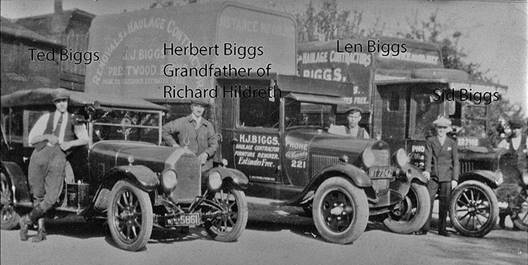
Herbert Biggs at his haulage yard, with relatives Ted, Len and Sid
The other large business in Great Kingshill, David Martin Nash's wheelwright business behind the White Horse on the sawmill site employed a dozen people during 1911-1931, but the woodland industry was in steady decline and this business declined with it, ceasing work at the time of second world war. A sign of the times was that one of Nash's workshops was used by Billy Anderson to build bicycles, a form of transport that was de rigeur for every household by that time, cars still being beyond the reach of most incomes before the war. He moved with the times, however, as after the war he established a motor garage on Heath End Road. The other garage in Kingshill started at the same time was Clarke's based at Cherry Tree Farm (taken over in the war to assemble aircraft components).
There were burgeoning shops in Prestwood providing some employment - such as
Smith’s sweetshop with its tin roof on Moat Lane;
a florist and the first Prestwood surgery (Dr Streub's?) at Blacksmiths Lane;
Crossroads Garage which repaired bicycles as well as cars and provided taxis;
M Lewis's homewares shop next to 26 High St (two doors from Oliver Wright's House), now demolished for new private housing; Gibbs’ barber's and J.B.Rance's butcher's (next to the Travellers Rest) on the High Street, where there were also a chemist, a grocer and greengrocer, an insurance office, a fish-and-chip shop (opposite what is now the car park, later replaced by a garage);
the old Post Office at Chequers Corner (Frank Bignal); A.J.Tompkins (poultry and fruit);
and Stevens's butchers on Wycombe Road.
Meanwhile Ralph Free, who in 1900 was a wood turner in Bryants Bottom, bought land from William Ridgely in 1921 on the corner of the main road through Great Kingshill and Hatches Lane. Here he founded a prefabricated grocer's shop, rebuilt in brick by Biggs & Sons in 1929, and now replaced by the modern SPAR shop. His son Reginald (1895), whose idea it had been, became the shopkeeper (see picture below), after training in food retail in High Wycombe, and he was succeeded by his son Garth. Until then most people had to rely on delivery men from far afield with horses and carts for food and various services. The first houses appeared in what was to be New Road (then called White City and just a muddy track) about the same time, and Mr Free was obviously alert to the possibilities provided by an expanding population.
As for women's occupations in the C20th , the era of “domestic service” soon declined after the first world war, and the traditional lace-making and straw-plaiting were both almost ended even as the century began. With better transport it was now possible for local residents to find jobs outside the parish in the even faster-growing towns. Women now found employment in dress-making, laundry, and as shop assistants.
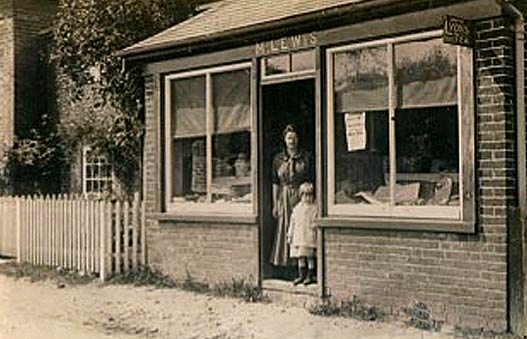
M.Lewis homewares shop next door to what is now 26 High Street, demolished for road widening and replaced by a shop set further back (see next picture) 1920s
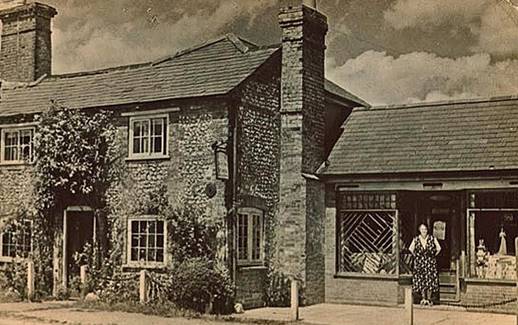
M Lewis's shop (now demolished) next to 26 High St (which has survived) 1930s
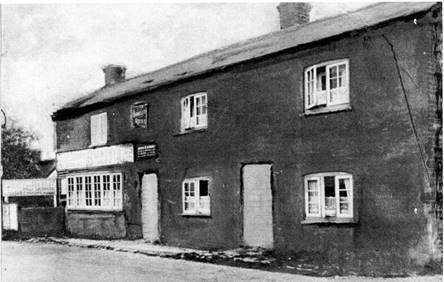
Travellers Rest before rebuilding c1930

JB Rance butchers, High Street
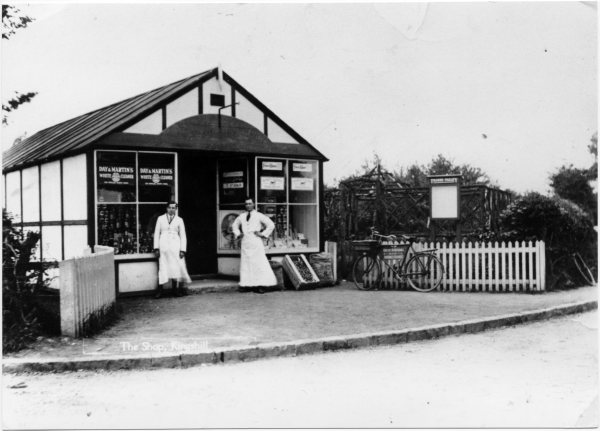
Grocers in Great Kingshill, 1920s. The two shopkeepers are Harold Biggs and Gerald Free. The occasion was the retirement of Gerald's father Ralph. The timber-framed shop was replaced by a brick building about 1930. [Photo: Bucks Free Press.]
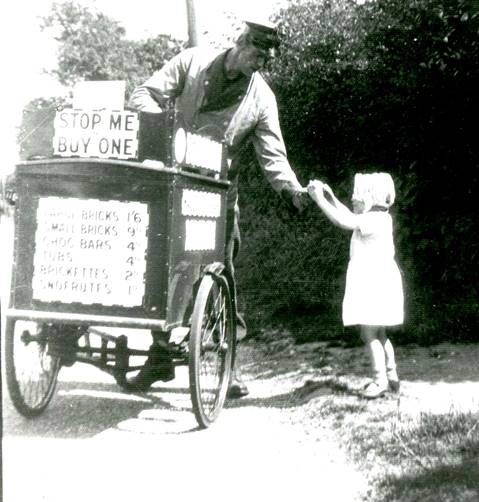
Ice-cream delivery
1934 - the girl is Audrey Rance
Community
A more secular age, with public welfare more dominated by central government than by local charity, had emerged and the influence of the Church was declining. The only new place of worship was a small wooden Roman Catholic chapel built beside Peterley Manor, the house of the Catholic Dormer family, about 1905, “with a thatched roof and leaded light windows”, but this was for private worship only until interned Polish servicemen used it during the Second World War (Coulon 2000). It has since been demolished and replaced by a modern brick house (‘The Old Chapel’). The building of this chapel was associated with one of the rare appearances of the Dormers themselves as residents at the Manor, between 1905 and 1907, this brief residence ending when the 13th Baron got into a financial scrape and had to sell off most of the remaining estate except for the house and its grounds.
The Church School was replaced by a new local authority primary school (Prestwood Council School), built on Moat Lane in 1908. (It took children up to the age of 14 in those days, although, for boys, there was also the Grammar School in High Wycombe and for girls the County High School there). In 1901 Moat Lane held 40 pupils. An account of Moat Lane school in 1911 has been left to us through a school essay by one of its pupils at the time, Emily Stevens (who was nine when she first arrived):
This school was built about three years ago. It was built because the old school was not big enough, and also in a bad condition. We first came here on February 14th 1909. On the morning we came here our parents came and saw us at our lessons. After we had been here about a fortnight the children gave a concert and the managers made speeches about the good of the school. The school now holds about 212 children. They are divided by partitions. There are a lot of windows in each room which give plenty of light; also they are well ventilated. There is a large hall in the middle of the school. In wet weather we have our drill there.
We have lobbies to hang our hats and coats in; each child knows her peg by the numbers. Each desk holds two children. The caretaker has a room provided for him.
The playgrounds are asphalted. They are very slippy. The boys and girls have gardens to cultivate. The things out of the gardens are sold and the boys and girls have half the money. We have maps of the different countries in each room, and a number of pictures. The boys learn woodwork, which they are taught by the head master [William Pitt, earlier headmaster at the Church School; he also gave private music lessons at his home, which Emily attended]. Different woodwork has been sent to India and other places. We have a piano and we do singing nearly every day.
Just lately two more rooms have been added to the school, one for the head master and the other for the children. For nature study some of the teachers take the children for walks near the school. We have a gong, and we here [sic] it, when it is time to go in school or out. There are plenty of cupboards to put the books and other things in.
In a separate essay Emily’s teacher (probably Miss Bristow) set her the task of imagining what the school would be like in ten years’ time:
I think that the school will be very much altered by 1921. I expect the school will have a lot more buildings added on to this. They will do different work, and much harder work. There might be different rooms to do each work in. The children will have better manners, and be much neater than they are now. The boys might be taught chemistry, and the girls laundry work. Their speech will be finer and cultivated like gentlemen’s and ladies’ children. The third and fourth standards will do the work, which the sixth and seventh do now. They might do home lessons at night. There will be more children come here to school. The children might go to school until they are sixteen.
Before Moat Lane School was built Emily Stevens had attended the church school. She appears at the age of about five in the class photo below, in the centre of the second row from the front. The girl behind her, with her hands on her shoulders, is her older sister Annie. To her left are her two brothers Sidney (6) and Herbert (8).

Prestwood Church School c1905.
Back row: Henry Adams, Lawrence Essex, Aubrey Parsons, William Timpson, Hubert Jeskins, William Mason, Edward Mason, George Redrup, Jack Jeskins
Third row: Schoolmaster William Pitt, Ivy Cummings, Florrie Wright, Greaves, Daisy Wright, Annie Stevens, Fanny Parsons, Morris Mason, Ernest Redrup, Ernest Adams, Hubert Groom (teacher)
Second row: Kathleen Groom, Constance Groom, Ada Redrup, Greaves, Maud Wright, Emily Stevens, Sidney Stevens, Herbert Stevens, Isabel Timpson, Nellie Parsons, Nettia Groom
Front: John Cummings, Sidney Wright, Cecil Parsons, Frank Redrup, George Mason, R.Hunt
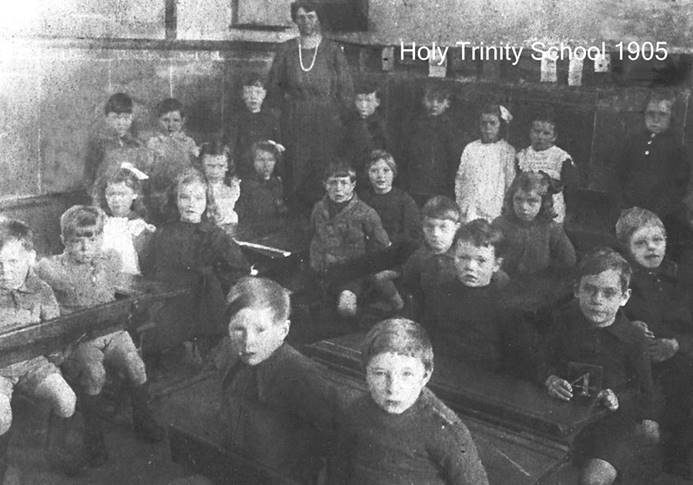
A classroom in the Church school 1905. Amy Pitt (wife of the schoolmaster), may be the teacher at the back
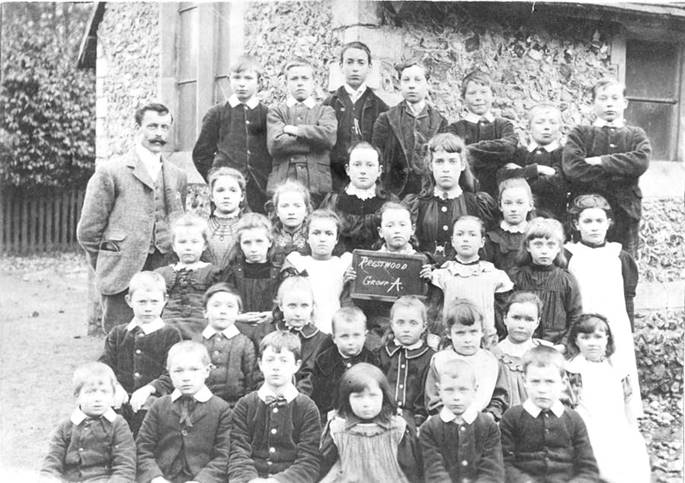
One of the classes at the Church school at about the same time, posed in front of the flint-built schoolhouse itself, Mr Pitt the schoolmaster at left
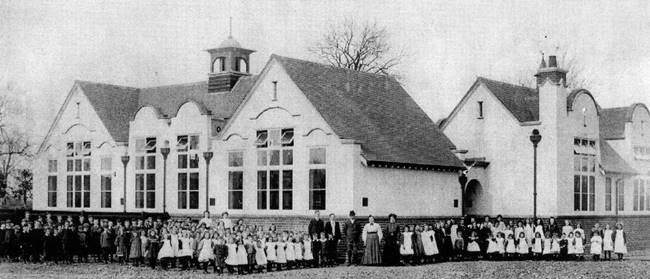
Moat Lane School c1908
Private schools were set up at various times at:
(i) Prestwood Lodge (eventually moved to Pipers Corner, see below);
(ii) Stonygreen Hall , until it was bought by the owner of Debenhams in London at the end of the 1920s;
(iii) Andlows Farm , then farmed by Mr Beeson, whose daughter Myrtle taught lessons there 1935-38. The housekeeping was managed by Lily and Ella Beeson, and they catered for up to 12 children of local businessmen, occasionally taking boarders. They charged 3 guineas a term plus 6d a day for dinner. An account of this school has been provided by Barbara Ridgley, a grand-daughter of Owen Groom (Prestwood Archive):
It was a great place to go, we played in the big field at the back, there was a swing in the biggest holly tree you ever saw, in icy weather we could slide on the frozen moat. The lav was a 2-seater built into the garden wall ... Miss Myrtle was an excellent teacher, the books were old, I can still see the quaint illustrations! She also taught piano, and some of the pupils did very well later. ...
The kitchen was like a barn, water was pumped up and a zinc bath filled, from which drinking water was scooped with an enamel jug. Cooking was done on a mighty oil range, there was an open hearth.
The stairs were lovely, wide low steps fine curving rail and delicate spindly banisters. All spare books etc were stored in the biggest bedroom, I was often sent to fetch things, remember the "old" smell. A closed-up room was found at the stairhead while I was there, no window, or contents, just dust! ...
I remember the old garden, so neglected, with apple trees, and a quince, and lots of horse-radish. It was a real farm, old fashioned even then, a stock farm, and we used to walk round the cornfields and woods on nature rambles.
In 1838 the farm was sold (by Missenden Abbey estate) and the school moved to Sixty Acres Road, in a bungalow rented from Mr Welch, much more cramped and unable to supply meals or take boarders.
(iv) Pipers Corner , established 1945 at a former farm just outside the parish boundary. This survives to the present day as a girls' school (all ages) with over 500 pupils. Former pupils include Virginia Anne Deradour, grand-daughter of Wren Davis and now manager of Collings Hanger Farm.
Upkeep of the grand vicarage could no longer be afforded and it was sold off in the 1930s as a private residence (later an hotel) renamed Prestwood Park House, along with “Prestwood Park” itself, where Thomas Evetts’s trees were still flourishing (he himself had died before the century dawned, in 1898). This field was kept as cattle pasture under the ownership of Wren Davis.

Prestwood Park today with central dry valley once followed by a hedgerow, of which just a few old trees remain
Some traditional activities common in the early part of this century gradually died out, along (thankfully) with stinging-nettle tea. This was to heightened by the hiatus created by the second world war, but carnivals, shows and football matches between the Up Common and Down Common teams were still a feature of most of this half-century. The schoolgirl Emily Stevens described some of these events. June 22nd 1911 was Coronation Day for the new king George V and Queen Mary:
In the morning I helped put the flags up and I saw the people get the things ready for the afternoon. About twelve o’clock I had my dinner and then got ready. In the afternoon I went into the meadow [presumably Prestwood Park] and waited until the people came from church [Revd. Thomas W Reynolds was vicar at this time] and then the children went to have their tea. They had a band and it played while we were having our tea. There was a man dressed as an Indian. After tea there were races in the meadow. And about five o’clock, nearly all the children had medals given them [which ones did not?] by Mr Bird [resident at Prestwood Lodge at this time]. Soon after the medals had been given, there were two greasy pigs and the men and women ran after them and those who caught them had them. I watched the prizes being given and then had games. Soon after I went home feeling very tired.
Summer holidays lasted for a month, beginning on July 26th that same year.
The next day was Prestwood Show. It was held in Mr Bird’s field. There were quite a lot of people there. [In her diary she adds: I had 2nd prize for my bonnet, and Annie [sister] had 1st for her rock cakes and second for her sandwich. Father had 1st prize for one of the horses in the tradesman’s class. There was an accident. Mr Munger of Aston Clinton was thrown out of his cart. He sprained his ankle very badly.] Prestwood Show had been started just five years before. At that time it took place in the field opposite Collings Hanger Farm (now built over), owned by Emily’s father.
On Bank Holiday Monday I went to Hampden Demonstration. [Sic, but this was no protest march! - more what we would now call an ‘open day’.] I went into Hampden House. It was where John Hampden lived. There was the room where he was arrested, when he wouldn’t pay the ship money.
On some Fridays I went to Wycombe. A lot of people were going there as it was market day.
On August Bank Holiday I went to Amersham Show. It is not so good as Prestwood Show is.
The second Wednesday, I went to the Sunday School treat which took place at Long Down. The children with their mothers assembled at the old school, and waited until all was ready. When I got there I went with some girls, and climbed the hills. When we got to the top we could see quite a long way. When we went down we had our tea. Afterwards I went up the hills again and had games. I was very tired when I got home.
[In her diary Emily describes Long Down as “ belonging to Prestwood Church ”. She also says that “ Nearly all who went had itch bumps the next day from sitting on the chalk. The children and teachers climbed the hill. You kept slipping back when trying to climb. ” This would indicate a steeper site than any of the fields near the church. The obvious candidate is Longdown Hill to the north of Great Hampden, which leads to Pulpit Hill and its extensive views, but this did not belong to the church. On the other hand, the field on the south side of Perks Lane, before the houses were built, used to be called Long Field and the wood at the top Longfield Wood. It is certainly steep and might have been referred to as ‘Long Down’. This may also have included the equally steep field on the other side of the valley, up which the Perks Lane gardens now climb to the edge of the current Picnic Site field, which is therefore another candidate, and not at all far from the church. The chalk itself would not have caused ‘itch bumps’ but they may have come from harvest-bugs, young mites common in grassland and corn August to September. In 1987 Geraldine Fisher was similarly “attacked” at the Picnic Site by these little creatures. Fisher's notebook records:
10th Sept ’87 at 7.00pm: On this short evening visit when I sketched Robin’s Pin Cushion, I also collected at the back of my knees an unwelcome group of Harvest Bugs (larva) Trombicula which like to literally “get under your skin”. They climb up one’s legs and usually stop and burrow in a restricted area – eg the back of knees when one is stooping, or under tight elastic of pants or girdle. They are smaller than a pinhead and just visible to the naked eye with a magnifying glass. They are tiny orange mites. I’ve seen them in groups in the fur of cats just under the surface skin. They like the Chiltern lower hill sides, not to be found on the flat paths of the valleys. Very much a bug of harvest time. ]
Emily continued: The Harvest Festival at Prestwood Church took place on Sept 27th 1911. The Archdeacon of Buckingham preached the sermon.
In her free time during the holidays Emily describes going “out for rides with the men” – ie her father’s workers - picking blackberries, helping her mum, reading, writing and playing with her brothers. She says her favourite game is hide-and-seek, especially “ when there are plenty of places to hide in like rambling old farms and houses ”.)
The above communal activities were a continuation of a long tradition of picnics and carnivals, particularly organised by the churches (see Keen 1997), with fields and barns provided by local landowners. They included games such as cricket, swings, donkey rides, races and ball-games, often for prizes of sweets or balls. One of the grandest was the Whit Monday Fête held at Peterley Manor in 1930, which was opened by Mrs Coningsby Disraeli of nearby Hughenden Manor (daughter-in-law of Benjamin Disraeli), and included a carnival, procession and fancy-dress dance (Keen 2002).
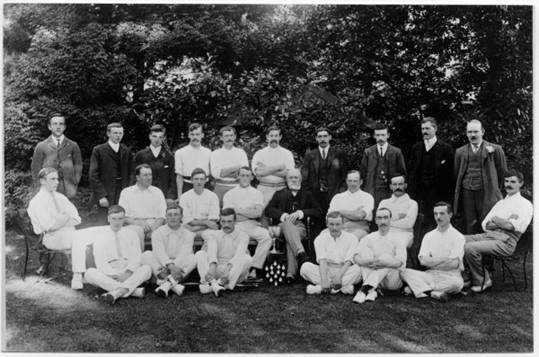
Kingshill Cricket
Club team and officers September 1907. [Photo by Sweetland; copyright High
Wycombe Library.]
Another major event was King George V’s Silver Jubilee on 6th May 1935. This started with a procession from the crossroads at the east end of the High Street and followed the latter as far as Nanfans Grange, then owned and farmed by Colonel Dresser, who supplied a field for the fête, involving fancy dress, sports and games. Miss Emily Wright won a prize for the “best decorated house” that had been passed by the procession along the High Street. The “best decorated vehicle”, presumably part of the procession, was a pram, created by Mrs A Gibbs from Flettons shop, also in the High Street. Tea was held afterwards at the Village Hall (see below), where at 8pm there were songs by the church choir conducted by the schoolmaster Mr Eade, followed by a concert and a dance. The grand finale was a bonfire on the recreation ground with fireworks. (Information from the Prestwood “Jubilee Committee Souvenir Booklet” 1977.)
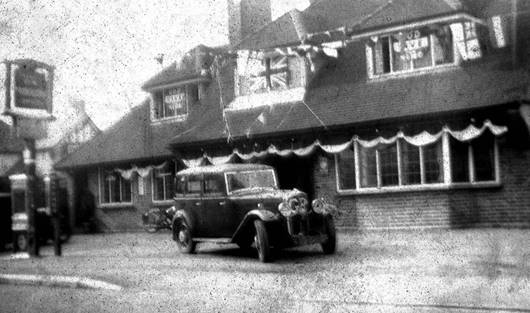
Travellers Rest decorated for Silver Jubilee 1935
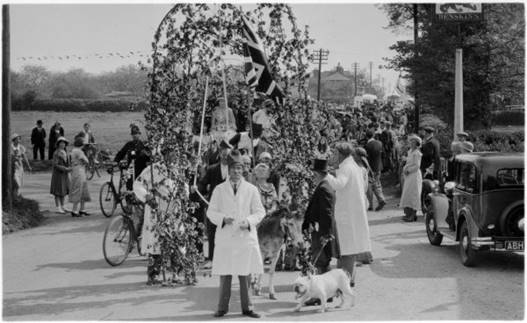
Silver Jubilee May 1935, part of procession in Great Kingshill outside the Red Lion
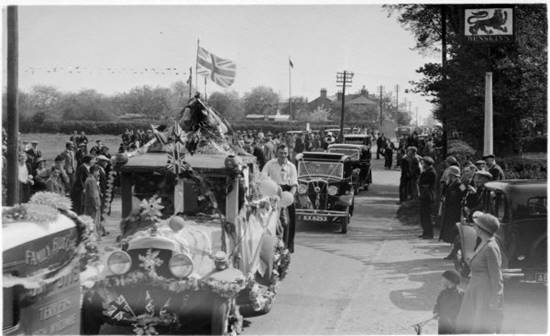
As above
Meanwhile, more formal provision for leisure activity was being made. The Great Kingshill Village Hall was built in 1913 on land donated by Mr Sharon Grote Turner, who lived from about 1907 to 1928 at a new large house at Peterley Corner. Prestwood Women’s Institute was founded in 1924, holding evening educational lectures, reflecting the impact of the Suffragette Movement. About the same time the first Scout group began, led by the then vicar Revd. TE Peters. Prestwood Village Hall was opened in 1928 (by Rosamund Parker, Countess of Macclesfield) on land donated by the Stevens family and with bricks donated by the Howards. One resident recalls (Doel 2000) “ …the village hall was the centre of the village and villagers used to put on a lot of entertainments such as concert parties, dances and weekly cinema shows. The village hall stands on land that was donated by Cornelius Stevens. Villagers raised money to help pay for the hall and my aunt, who was a girl guide at the time, helped construct the mile of pennies which stretched from the ‘Green Man’ down to ‘The Chequers’.” It was built by the Parsons family who ran the Green Man as well as a building business.
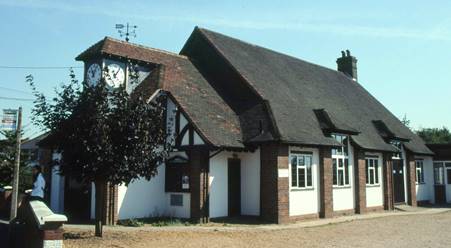
Prestwood Village Hall in 2000 (the year the clock was added to mark the Millennium)
In previous chapters it has been necessary to refer to the great estates and mansions bordering Prestwood parish - Hampden, Hughenden (Disraelis), Missenden Abbey (Carringtons) and, to a lesser extent, Peterley Manor. Although impinging little on the day to day life of the parish, these noble families constituted the local representation of the wider society, the national context. They were important economically and socially - it was largely through Disraeli that the parish was formed at all. If little encountered, people were still acutely aware of their existence. They were the grand background to the ordinary person's mundane life. When the Carrington "ladies" passed down Great Missenden High Street, men doffed their caps and business stopped momentarily out of deference. In the C20th , and particularly after the First World War, these grand houses faded very much out of view, partly because of wider changes in society, the dropping of the final vestiges of feudalism, the rise of working-class politics, but also because of declines in the noble families themselves.
A good example is what happened to the Hampdens during the years covered by this chapter. At Hampden House, Sir Sidney Carr Hobart-Hampden assumed the further surname of Mercer-Henderson by royal licence, thus incorporating his wife's titles and fortune, becoming Sir Sidney Carr Hobart-Hampden Mercer-Henderson. He had been an Honorary Lieutenant-Colonel in the 4th Volunteer Battalion of the Oxford and Bucks Light Infantry and received an OBE in 1919. He was active in the Lords and devoted to reform of that House, which led him to switch from Conservative to Liberal when his party opposed such measures, but he became ill in 1925 and by 1928 had not long to live. At that time his heir Bertie was estranged from his father and the rest of his family, residing in Brisbane, Australia, living a life of some dissolution centred on drinking and gambling. On receiving a telegram about his father's illness, however, he returned home in April 1928 and patched up his relations with his father, possibly with one eye on preserving his inheritance, vital to continuing his life of leisure. He never mended his relationship with his mother or elder sister Lady Dorothy Hope-Morley, who had bullied and treated him cruelly as a child. He escaped from this conflict in a relationship with the young trainee domestic nurse, Margaret, then employed to care for his father, giving her a child and then rejecting her. His father was able to contain the scandal and the family name, but he died in 1930 and Bertie came into his inheritance, managing to fritter away the family fortune in his habitual pursuits in London, while continuing to sit in the House of Lords. By 1938 he had to sell the Hampden estate, which then ceased to belong to descendants of the Hampdens. He died in 1963 having wasted a fortune and bringing ruin to his family. (Tomlin 2009 "Sons of Soldiers"; Simon Tomlin, the author of this book was the son of Margaret's love-child by Bertie Hobart-Hampden.) The more double-barrelled surnames they acquired and the more the family married within itself to accumulate honours and fortunes, the less relevant it became.
A Portrait of Rural Life in the Thirties
by Winifred Peedle
[This section constitutes major extracts from an unpublished account by Winifred Peedle, who was born in 1908 and lived all her life in Prestwood until the end of the century (when she went into a nursing home in Wendover). She wrote it as a student teacher project just before the start of the second world war, and it gives an invaluable and unique glimpse into life in Prestwood during the thirties. A large part of the dissertation described the local flora and wildlife, in which Miss Peedle took a particular interest. I have reproduced the greater part of this account word for word, for not only is it a vital record that should not be lost to posterity, but it is also delightfully written with real feeling for, and understanding of, the rural life of the time. We are honoured to have it, and I would like to express my gratitude to Miss Peedle’s nieces, Margaret Crone and Mrs Watson, for bringing it to the attention of the Prestwood Society and allowing us to use it here.
Margaret Crone provided this pen picture of Winifred Peedle and her family:
“ Winifred was the youngest child of William and Rosa Peedle [ née Hildreth ]. She was born at Primrose Cottage, Sixty Acres Road [ on the former Prestwood Common ], in October 1908. She lived in Sixty Acres all her life, until she had to go into a nursing home in 1995, where she still lives [ 2002 ], aged 93. She had one brother Ernest and two sisters, Annie and Edith.
Her father was a fruit and vegetable dealer with several cherry orchards in the village. He kept pigs, poultry and goats. He sold his produce and what he collected from other farms locally, at Wycombe and Aylesbury markets. He took them in his horse and cart.
Her grandfather, Simeon Peedle [son of William Peedle encountered in the Prestwood census of 1851 living by Prestwood Common ], was a fruit and coal dealer in the village, and her other grandfather, Benjamin Hildreth, was the village blacksmith.
Both families had strong links with Prestwood Methodist Church. Her father was a Superintendent and Winifred played the organ there for many years. Her grandfather Benjamin crafted the gallery in 1869. Winifred and her sister Annie were Sunday School teachers.
Winifred won a scholarship to Dr Challoners Grammar School, Amersham. She was a teacher by profession and her first position was at Ludgershall. She taught at Prestwood School [Moat Lane] during the 1930s and then went to Teacher Training College. After graduation she went to Oak Green School, Aylesbury, where she taught until her retirement in 1968. She didn’t marry, but was devoted to teaching and all the children she taught. ”]
Extracts from Winifred Peedle's Account
Soil
At one end of the village there is a Brickyard where the men have been digging out clay for more than thirty years. About 100 yards from my home there is a field where huge sandstones used to be found and dug out about 30 years ago. Near the beech woods are cornfields where the soil is chalk and flints.
There are quite a number of springs in Prestwood. The water soaks through the top layer of chalk until it reaches the clay. Some of the springs have been discovered when men were digging cesspools, etc. Several years ago when they were digging a soak-away at my home, suddenly the soil gave way. The man was able to get on the ladder and out of the hole, but his spade was carried away under the earth, and the hole had to be filled in.
At another place in the village, men had dug a hole deep enough for a cesspool. The morning after they found it partly full of spring water. (This was very fortunate, as this was at a time of drought.) The men were able to use the water for mixing cement instead of carrying it there, for each morning water was found in the hole.
Beech
Bucks is noted for its beech trees, and nowhere in Bucks are they lovelier than they are in Prestwood, especially at the end of April and the beginning of May. The trees here are not allowed to grow to a very great age, as they are needed for the local trade of furniture making. The tops are not lopped as they were at Burnham Beeches. The trunks grow tall and straight, and the bark is smooth and grey. … The soil under the beeches is very fertile. Children often gather the leaves in bags to take home to use in their fathers’ gardens. …
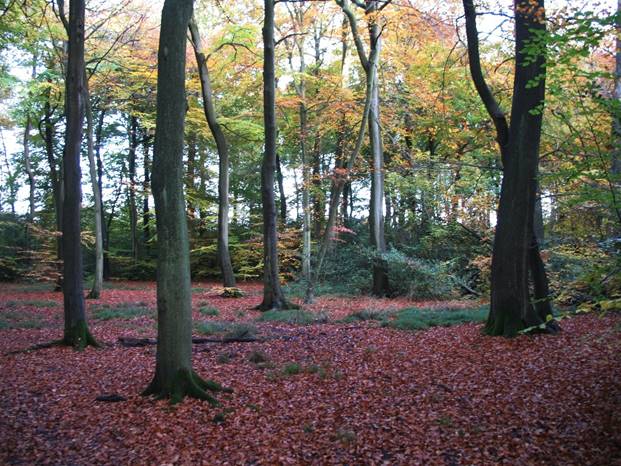
Beechwood, photo by Val Marshall
The old craft of the ‘chair-bodger’ is still carried on at Prestwood. An old man has set up his hut (walls made chiefly of shavings). He still uses a primitive lathe and turns legs and spindles for Windsor chairs. (The hut used to be in the wood, but now that the old man is over seventy, he has set up his hut in a field near his home. He and his hut have been taken to Exhibitions in many parts of England, and he has been filmed. He is very proud to think that several of the Royal Family, including the present King, have stood to watch him and chat to him at his work.)
Beech wood is also used for the legs of other chairs, sofa frames and many other kinds of furniture where heavy wood is required. It is much easier to carve than oak. Beechen bowls are also carved in the next village.
When the trees are going to be cut, they are selected carefully. Marks are placed on all selected trees, and then the fellers come to the woods. Then more trees are planted. An old Bucks proverb is ‘Cut a beech and have a beech’. They are a valuable crop. The owners of the land will continue to plant them as long as chair making is carried on in High Wycombe. …
Larch
There is a lovely smell of resin as you walk through the larch woods. Locally, these woods are called the Pine Woods. Another name for them is Cathedral Woods, as the straight trunks of the trees rise high on either side of the path and the branches meet overhead, forming arches. … The branches at the top are so thick that they exclude the light from the branches below. These under-branches die and fall to the ground, where they are found by the children and taken home for firewood. Larchwood makes a loud popping sound, and small pieces often fly out from the fire. It gives off a pleasant smell when burning. …
The main uses locally for larches are for fencing, pergola work, telegraph and wireless poles. They are also used in other places for railway sleepers, pit-props and dug-out props. …
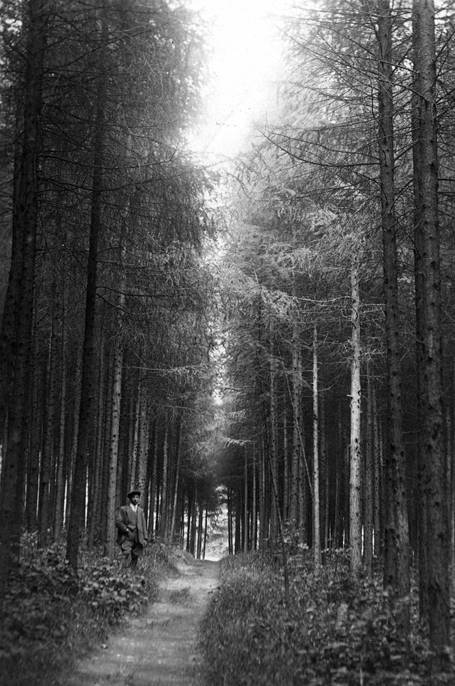
The Pine Woods c1910
Cultivated Cherries
(April 26th.) Today there is a continual buzz in the cultivated cherry trees, as the bees fly from one flower to another and pollinate them. It is a very curious thing, but the blossom of the late cherry always comes out before that of the early cherry.
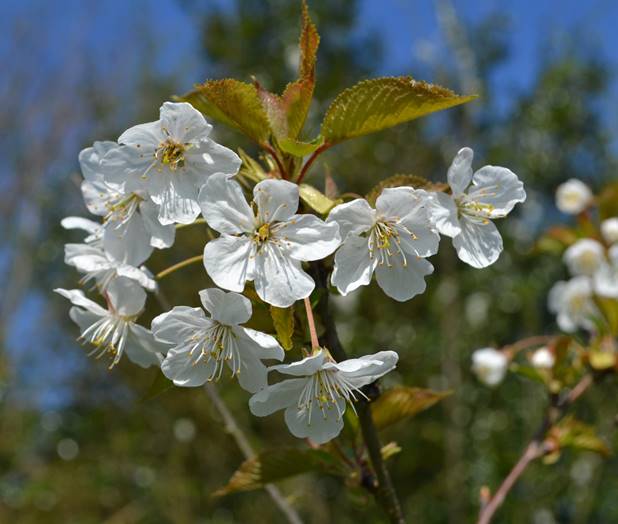
'Prestwood Black' cherry
There are many cultivated trees here. Prestwood is noted for its beauty at cherry-blossom time. Some of the trees grow to a very great height.
A method often employed here is for a dealer to buy the fruit when the trees are in bloom, and then to employ his own pickers. There is a great risk. Some years most of the fruit is damaged by frost, storms and rain. It has also been split by light, steady rains. Then some years there is a glut, when it is difficult to even give the fruit away.
In July the fruit ripens, and then begins a very busy time here for a few weeks. Every available man is employed picking the fruit, and even the women help. The fruit must be very carefully picked or by the time it reaches the markets it will be split and spoilt.
Bird scarers are employed, for hundreds of birds will visit the orchards attracted by the bright colour of the juicy sweet fruit (red, white and black). Scarecrows are placed high up in the trees, and bits of tin with clappers which make a continual clatter when the winds blows. Bits of mirror are hung on the branches to catch the sunlight and make a really frightening dazzling light. Men also walk round the orchard with clappers and a gun.
The birds are very artful. They watch the scarer, and when he comes to their end of the orchard, they fly to the other end and feed there till he returns.
Bird scarers and pickers get up very early in the morning and work till late at night.
The ladders used are very long. [The tallest were 60 rungs.] They are often rested against very slim boughs. The pickers have to put one leg through the ladder so that if the bough breaks and the ladder slips in the tree, they will go with the ladder, and not fall to the ground.
Stony Green Bank
[Miss Peedle refers many times to a particular bank rich in wildflowers, and this spot forms the central focus for her account. It is apparent from other details in the account that this bank is the same as what is a now a local nature reserve, Prestwood Picnic Site. Nowadays "Stony Green Bank" usually refers to another chalk hillside between Stonygreen and Nanfan Woods, a kilometre further north.]

Prestwood Picnic Site (centre) from the top of Denner Hill
The bank in Spring and Summer is always a mass of colour. In Spring the deep blue dog violets thickly cover it. Later the cowslips bloom abundantly, with stems shorter than those growing in the neighbouring meadows. In Summer there are milkworts, blue and pink, clustered bellflowers, scabious, knapweed, thistles and harebells all growing abundantly, and at the bottom of the bank there are masses of rose-bay willowherb. [This last plant was, in the next decade, to colonise in profusion every wasteland in our cities devastated by bombing during the war.]

Cowlsips, Prestwood Picnic Site
|
|
|
Milkworts at Prestwood Picnic Site. Left-hand photo by Val Marshall
Each year on August Bank Holiday, prizes are given for the best collection of living wild flowers. The chalk bank is one of the favourite hunting grounds for treasures. The children have been asked to pick only the amount they will require. After the children have finished picking, there are still hundreds of flowers left.
Gorse does not grow so abundantly here as it did on the commonland about a mile away. All this gorse, however, has now been destroyed and the land laid down for a recreation field. [This refers to the remnant of Prestwood Common beside Nairdwood Lane, still used as a recreation ground - and still remorselessly gorse-less.]
One half of the bank has been sold, and this part has been fenced off and is now kept private. This half has not been cleared for over 15 years. Hawthorn, bramble, wild rose, whitebeam and wild cherry have been allowed to grow freely. They almost cover the bank, but fewer flowers grow there now. The best orchids grew there and the cowslips were finer. [This was the south-facing part of the bank that the Perks Lane housing development was soon destined to cover.]
Pheasant Farming
(April 19th 1939.) Today I have been sitting on a bank opposite to a large field of pheasants. The field in which these pheasants are kept is well protected from severe winds by wooded slopes. The field itself is on the side of a hill, and is therefore well drained. [Across the valley from Miss Peedle’s bank lies Denner Hill. Pheasants have been kept there to this day, although the woods have largely gone.]
The laying season has begun and on this hot Spring afternoon, the best adjective I can use to describe the noise coming from the pheasant pens is a ‘busy’ noise. It is a noise which has the effect of making any listener feel very drowsy.
The field is divided into small pens. Each pen contains one brightly coloured cock bird and five hen birds. The pens are surrounded by fine mesh wire netting, firmly fixed to larch posts. (These larch posts have been cut from the larch woods, about a quarter of a mile away.) The outside pens have higher netting, about 8ft high, and on the top is fixed another 3 feet which slopes outwards, to prevent vermin from running up and entering the pen in that way.
Last year the birds began to lay on the 25th of March, but this year the first eggs were found on March 28th. The weather had been bitterly cold previously and this may account for the later date, although the usual time is the end of March or the first week in April.
The male pheasant is a more beautiful bird than the female. It has a long tail, erectile ear tufts, brightly coloured feathers and a featherless red face. The female has a shorter tail and is browner. In the mating season the cock pheasant displays his charms to the hen. He runs around her with much sidling and wing trailing action.
When in captivity these birds simply drop their eggs in odd corners. The keeper has to tread very carefully, for it is very difficult to see them on the ground. The keeper goes around collecting the eggs three times a day, for the cock pheasant will sometimes eat the eggs. They must therefore be collected as soon after laying as possible.
These, the first eggs, are being collected to be sent abroad where they will fetch a high price. Eggs at home often cost 8d each for the Common Pheasant, 10d to 11d each for Blacknecks and Chinese, and 1s 1d to 1s 2d each for Mongolian Pheasant eggs. [Pre-decimal prices; 12d, or 12 old pence, made one shilling, equivalent to the modern 5p; Mongolian Pheasant eggs at 1 shilling and 1 or 2 pennies therefore cost in today’s equivalent 5½ to 6p. They would actually cost about £1 nowadays.] When all the orders are supplied the keeper will begin to put down the eggs, which are very fertile at this time. It is a rare thing to get a ‘dud’ (as the keepers call them).
For some time before this, the pheasant farmer will have been busy collecting sitting hens, for the pheasant is not allowed to sit on its own eggs when in captivity. 17 eggs are placed under a small hen and 21 for a large one. The hens are taken off for a short time each day for food, and replaced before the eggs become cold. The eggs hatch in about 20 to 21 days.
At first the little chicks are very shy. Their colouring is very pale. They are kept with the hen for about 6 weeks to 2 months, and then all the young birds are put in a pen together. They need protection from the sun because their heads are almost bald. A patch of grass or clover is left where the little chicks may seek protection during the hottest parts of the day, and where they will run from the coops, if frightened. They sneak through the grass with lowered heads.
Four faggots are stuck up in the middle of each laying pen to give the older birds shade.
At the edge of the beech wood is a small chalk pit. Loads of chalk are brought to the pheasant farm, broken into fairly small lumps, and placed in each pen. The birds peck and swallow some of the chalk, which helps to make and harden the shell. There is also a heap of sharp grit in each pen. This helps to grind the corn in the bird’s gizzard.
The adult birds are given a mash – hot and dry – in the morning. This consists of biscuit-meal, Sussex Ground Oats, Middlings, Meat Meal and Bran. All these are mixed together and a ball a little larger than a tennis ball is given for each 6 birds. Wheat is given in the afternoon. The birds will also feed on grass and are often put in a field of clover. A fairly tall strip of clover is left standing near each line of coops.
Pheasants will drink very large quantities of water. Several times when I have looked into the pens the troughs are quite empty. It is impossible for the birds to overturn the troughs as they are very heavy – made of iron. Therefore the birds must have drunk the water. The troughs are filled twice every day.
Both eating and drinking utensils are carefully cleaned out every day, for cleanliness is very important when rearing pheasants.
The coops are placed on the leeward side. When the wind changes, the keeper must go around turning the coops. A strong wind will make the eyes very sore.
For some time the birds are unable to fly over the top of the pen. When they are old enough, and strong enough to do this, the wings are tied. The first season the left wing is tied. This destroys the balance. It is very amusing watching the birds trying to fly. They can fly to a height of about 3 feet even with the wing tied. Then they fall over to one side. The second season the left wing is left free and the right wing is tied, to prevent soreness. If the birds do manage to get out they are caught with a net fixed to a circle of strong wire attached to a long pole. …
When dusting they make very deep holes. They have been known to make holes so large that they are able to get under the wire into the next pen. They clear all insects from the ground. Wireworms are never found where the pheasants are.
Young birds in too good a condition (ie too fat) often become egg-bound. They lie over on their left sides as if dead. Olive oil is worked in around the cloacal opening of the bird, and the keeper helps to remove the egg with the first finger and the thumb. The olive oil soothes and helps to heal the sore place.
The Catching-up Season depends largely on the state of the birds, but is usually in August and September. All the pens are then opened into one. (The birds may still be laying a few eggs.) It is not at all unusual at this time to see the cock-pheasants fiercely fighting. They will fight to the death. Before a fight begins the two face one another with lowered heads, and feathers fluffed out around their necks, and then strike hard with the backs of their feet, using their spurs.
The birds are sent away for shooting at the end of the second season. They are sent in ‘flats’, 4 feet by 2 feet 6 inches, holding 2 dozen birds. As they are going long distances by train, both feeding and drinking troughs are placed inside the flats.
The birds kept for stock are also caught at this time, and placed in a pen, the winter pen, all together. Here they are kept until the following February, when they are again caught and put into their laying quarters.
Young pheasants are very susceptible to ‘gapes’. [A disease caused by a threadworm in the bronchial tubes.] The old method used to get rid of this was to put a piece of grass down each individual throat and remove a small worm. Now they fumigate to get rid of it.
Occasionally, too, they suffer from a disease called the Roup, a disease from which hens also suffer. This is a very serious matter then for the pheasant farmer. About ten years ago a whole pen (approximately 600-800 birds) was completely wiped out. But this is much more rare now.
There are so many enemies of the pheasants that the keeper has to be on duty all day long. At night he sleeps in a wooden hut. Outside is a dog which hears any unusual sound. The keeper always has a gun ready loaded near at hand.
Predators
The enemies of the pheasants are rats, foxes, stoats, and weasels. Carrion crows, magpies and hawks are also enemies of the baby pheasants. [Prior to the C19th the polecat might have been added to this list, but by now it was extinct in the area. It has only just returned and now breeds locally once again.]
Last year a pair of magpies had a nest in a drive near to the pheasant pens. When the keeper was going on his feeding round, they would wait until he had gone to the other end of the field (when they would be out of gun-range) and then they would carry off a tiny chick. The hawks, too, would wait until the keeper was out of the way and then swoop down from the beech woods nearby and take off the chicks.
Traps are placed all round the outside of the pens to try to catch the stoats and weasels. Snares are set for the rats, for, if caught by the leg in a trap, they have been known to gnaw off that part of the leg and so escape. The rats will carry off pheasants’ eggs. They often disturb the hens when sitting, and will attack them by the throat. [Miss Peedle drew a diagram of a rat snare. It consisted of a hazel stick fixed into the ground, with a ring of wire attached to the top end by a long strong string. The stick is bent over and the ring lightly fixed into the earth, attached to a horizontal stick held in the notches of two upright sticks. She notes: “ Rat running through grass is caught by the head in wire ring. Struggle to get free pulls ring free from earth and also causes top stick to be pulled out of notches. Bent hazel stick springs back into upright position, and rat is left hanging in mid-air .”]
Stoats and weasels may come in the day. If caught, many of them are hung on the wire-netting around the pens to scare away the birds. The vixens may also come during the daytime if they have any young. Last year some raids had been made on neighbouring poultry farms by foxes, and other farmers were then warned. Traps were set at all farms. Outside this pheasant pen four traps were set, placed to from a square, and an old hen was placed in the middle as bait. During the afternoon the keeper heard a yelping noise, caught up his gun and ran as quickly as possible to the place where the traps were set, for foxes too will bite their way out of a trap. At first the keeper thought it was a dog in the trap, for the tail of this animal was very short and stumpy. Apparently it had been caught in a trap before by the tail and had managed to escape.
Fox hunting is carried on in this district; therefore, to a certain extent, foxes are preserved. If a fox raids a poultry farm, the hunt will pay a certain sum for each bird killed. This does not always compensate the farmer, though, especially if the birds are young laying pullets. Last season many traps were set in Prestwood and foxes were shot. The hunt was stopped several times by outbreaks of Foot and Mouth disease in the district, with the result that the foxes became much more common and more poultry were killed.
One evening, several years back, a man came to our door carrying a dead fox in a sack. It used to be the custom for a man to shoot a fox and then take it round to all the people owning many poultry. They expected to receive some money for saving the farmer possible losses. This, however, was kept secret from the hunt.
It seemed, about this time, that the fox was in danger of extinction in the village. One woman bought the skin of a fox for 30/- [30 shillings, £1.50 in today’s terms] and had it cleaned and made into a fur. It then became quite the fashion amongst the women to wear fox furs. The coats of these foxes were a lovely russet with white on the underparts.
In winter, when there is a litter, they will raid poultry pens. Although I live at least a mile from the woods, we have several times been visited by foxes. It is fairly easy to discover whether it is a fox that has killed the poultry, for they will bite off the heads, while a stoat will wound them behind the head. The fox creeps through holes and will even climb enclosures. They kill far more than they need and leave the headless bodies in the pen. They carry several away and may return for more, burying surplus ones.
I have seen a fox caught in my father’s poultry pen, several years ago. It was in a very vicious state and snapped fiercely as we went near the trap. The trap was fastened securely in the ground, or the fox would have dragged it off. When a farmer hears the cry of a fox in a trap, he goes at once to shoot it, for foxes often manage to escape, leaving part of a leg or the end of a tail in the trap.

Stoats, more than weasels, will raid poultry farms. When a stoat is caught in a trap, the keeper will sometimes hide. He is often able to catch more, for others come round the trap as if fascinated by the dead body. Once stoats start killing, it seems as if they work themselves up into a frenzy, for they will keep on killing until they have destroyed all the living creatures around them.
Winifred Peedle
Prestwood in the Second World War
The above account written only months before the outbreak of war describes an episode of rural life still rooted in the traditions of centuries, but already in the process of change through the progress of technology and economic forces. The war itself marked a sudden and brutal transition that was to take the whole of Britain into a very different ‘modern’ era.
Like the first world war it affected Prestwood parish through the loss of many of its young (and not so young) men. The rural isolation of Prestwood was also invaded by the wider world in the form of fighting forces themselves, and residents of the time never forgot the amazing sight of huge tanks rumbling down the High Street. A prisoner-of-war camp manned by Canadian troops was set up in Peterley Wood, partially clearing the trees. The prisoners worked locally in the fields. For a few years after the war the camp was retained to hold refugees from the Royal Serbian Army. The remains of the concrete foundations of the bunkers can still be glimpsed in the southern extensions of the wood today, although pines were replanted in the area when the camp was demolished.
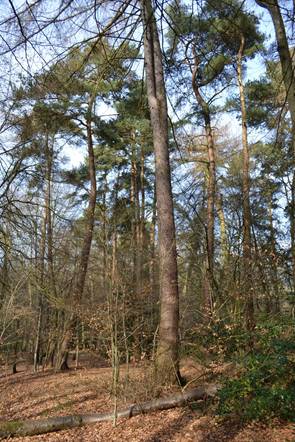
Pine plantation in Peterley Wood that replaced the wartime camp
Large houses were requisitioned as military hospitals and so on, including Peterley Manor, which became a base for soldiers preparing for the Normandy landings and later for German prisoners of war, and Prestwood Park House, the former Vicarage, which had been converted to a hotel in the late 1920s. Unlike some properties so used, those in Prestwood suffered little damage other than that from lack of maintenance for a few years. The water-tower at Nanfan Farm was used as a look-out post by the Home Guard and Air-raid Wardens, while there was a searchlight battery manned by the Home Guard on Nairdwood Lane. The Brickfields along Honor End Lane were used to store military vehicles and equipment, and a few months after the end of the war there was a mammoth sale there of those that were discarded. Dealers came from all parts of the country to buy motor-bikes, cars, vans, trailers, and lorries piled high, as well as mobile churches, cinemas and ambulances. War-time medical waste was also dumped in a small wood near here, just off Hangings Lane.
The RAF requisitioned Springfield, the large house at the southern tip of Great Kingshill, and the Chief of Bomber Command (based at Walter's Ash), Arthur 'Bomber' Harris, was stationed here from 1942 to 1946.
A greater impact was made by an air-crash in 1944 (see below) very close to the village, with debris scattered over many gardens, and a bomb which landed on a hay-rick in fields by Kiln Road belonging to Major Porter (where the houses of Over Hampden now stand). The latter shattered all the windows in the area and damaged many of the houses.
Land-girls, re-housed from London under blitz, were billeted at Little Hampden House (now The Lodge), former home of Colonel Challoner. The Ministry of Agriculture and Fisheries put them to work in gangs of six and they were hired out to local farmers as part of the wartime home-production effort. They worked in the fields, with the combine harvesters hired out by Hotley Bottom farmer Rupert Taylor, under the direction of one of his sons, at dairy farms, at a market garden, helping gather the cherries at harvest time, and one even worked as a rat-catcher. Prisoners of war were also set to work on the farms, many as late as 1947, some putting down roots in the area and remaining.
Other evacuees from the city were also numerous, hundreds of them being put up by local householders. One family lived in an old railway coach in fields on the east side of Greenlands Lane belonging to Mr Groom. A doctor took up residence in an old wooden caravan at Stony Green.
The influx of newcomers may well have stimulated the social life of the village. A dance was held in the Village Hall twice a week to raise proceeds for local service-men and -women. Saturday night dances continued after the war with proceeds going to a number of local charities. A special bus brought people from as far as High Wycombe. The recreation ground on Nairdwood Lane, the last uncultivated remnant of Prestwood Common, was finally ploughed up to grow food which could no longer be imported because of shipping blockades, but the local football team were allowed to play on a field at Nanfans Grange, then owned by Colonel Dresser, while the cricket team had to make do with a field near the Chequers Lane allotments owned by Freddie Welch. Children at Moat Lane School (then the only school in the area, catering for all ages) took part in the “Dig for Victory” campaign by making a garden to the rear of the school.
(Thanks to Mrs Frankie Westlake, whose unpublished memoirs of life in Prestwood around the time of the war supplied many of these facts; to Ron Hatt of Honor End Lane, Prestwood, in an interview with Marilyn Fletcher; Ron Hawes of Chequers Lane; and to Coleman 2014 for additional details.)
There was one event that brought the reality of war much closer to home than expected. The story is told by Derek Sadler, major extracts from whose report (Sadler 2000) are included here by permission. A plaque commemorating the event was erected outside the tea house at Hildreths Garden Centre.
Prestwood Air Disaster 1944
by Derek Sadler
From the start of hostilities in September 1939 through to victory in May 1945, Bomber Command expanded from a poorly equipped daylight bombing force to a massive offensive operation which, using four-engined bombers with new electronic navigational aids, and operating from airfields in the UK, attacked targets from Norway in the north, the Balkans in the east and Italy in the south.
To ensure that sufficient aircrew were available to meet the demands of an expanding Command and also to replace the ever-increasing crew losses, it was necessary to have an efficient Training Command to supply the specialist aircrew members. After training in his speciality each individual was posted to an OTU (Operational Training Unit). Here they would be trained to operate as a bomber crew, learning essential knowledge from experienced comrades.
Just such an OTU was No.83, operating from RAF Peplow in Shropshire, which operated Vickers Wellington Mark 10 bombers. The use of these aircraft by the main force of Bomber Command in the UK had ceased at the end of 1943, and by this date they were essentially restricted to OTUs.
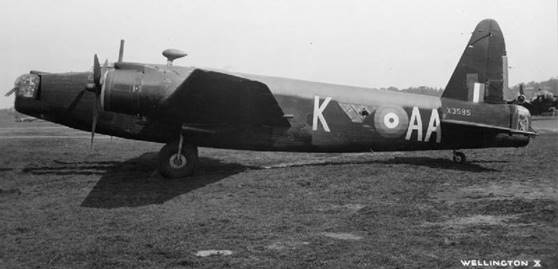
On the night of Friday 25th August 1944, two Wellingtons took off from RAF Peplow. They were airborne one minute apart to practice a night navigation exercise termed a ‘bullseye’. Usually a bullseye involved a cross-country flight incorporating several different turning points that could be situated anywhere in the UK and was meant to give the trainee crews experience that would bind them together into a cohesive unit. Along the route they would most probably make a dummy bombing attack on a specified town.
The first Wellington was piloted by Flying Officer Erik Michielsen, a Dutchman. All five of his crew were British.
The second Wellington was piloted by Flying Officer Elwood Smith, a Canadian. Four of his crew were Canadian with one Englishman.
At 1.25 on the morning of Saturday 26th August these two aircraft collided over the village of Prestwood and fell as burning, disintegrating wrecks into the village.
At the time, Mr Gibbons and Mr Bignall (village postmaster) were on duty as Air Raid Precaution (ARP) Wardens. As there had been no ‘alert’ they made their way back to the ARP Hut, situated behind the Village Hall, to get some rest. They were awoken by a bang and a thud as an engine landed nearby, showering their hut and the village hall with mud and stones. The hut lights started to flicker and went out (the electricity power lines were, and largely still are, overhead in this part of the village).
They both went outside and met Sgt. Free, Special Constable. They could see the light of fires in the distance but Sgt. Free said “It’s all right, it’s in Speen.” Both the Wardens disagreed and said it was in Honor End Lane. Mr Bignall got on his bicycle to go and take a look while Mr Gibbons telephoned the emergency services in Great Missenden. Mr Bignall returned saying that “A plane has hit the side of a house”.
As they made their way down Honor End Lane they heard a cry for help in the field on the left-hand side of the road and together with a woman ambulance driver they found a crew member in the Sheepwash Pond. It is believed the crew member died before reaching hospital. They started to search and found a further four bodies in the fields behind the pond. The parachute of one had been deployed but was assumed not to have inflated. Another crew member was found with his hand still gripping the parachute release, but it was unpulled, suggesting that the bale-out was at a comparatively low altitude. A further body was found in the Brickfields, still in his gun turret. Mr Gibbons then went on to his work at the village bakery, unaware that not one, but two aircraft had in fact crashed.
The father of Mrs EG Smith (née Groom) owned land around the area where a lot of the wreckage landed. At that time they lived in a farm in Kiln Road and had an evacuee from London living with them. They had all gone to bed when they heard a ‘loud noise’ and her father shouted “Something has fallen at the back of the farm”. Her father got dressed and went outside, together with the evacuee. She says that they found an airman in a holly tree, still alive but groaning, and that Dr Wilson was sent for but the airman died before he arrived. Part of an aircraft had fallen onto buildings behind the farm and Mrs Smith remembers that the next morning she had to lead the horses so as to avoid the fallen wires.
The late Mrs Hilda Beesley, then owner of Clarendon Farm, Clarendon Road, saw the falling wreckage of the two aircraft, locked together and ablaze. She told her family how she had been awoken by the noise of the collision and ran to her bedroom window. She watched in horror as the main pieces of the aircraft fell only a few hundred feet away from the farm. Two engines crashed down into her fields and blazing aviation fuel sprayed over a group of cherry trees near the farm house.
The aircraft that Mr Bignall had reported as ‘hitting the side of a house’ was in fact a wing and part of a fuselage of one of the Wellingtons. A tall tree fortunately prevented the wreckage actually hitting the cottage, now called Greenlands, but then occupied by Mr and Mrs Holt, the Baptist minister and his wife. Tremendous fires burnt around the cottage, setting fire to the newly tarred road. As the cottage had no rear door Mr & Mrs Holt were forced to flee out onto the road and through the flames, both receiving severe burns that meant they had to spend many months in hospital. Mrs Holt received 75 skin grafts.
The noise of the crashing aircraft had startled many villagers from their beds. Bill Howard went out with his brother to search the area and found the only surviving crew member, the Navigator from Michielsen’s Wellington, Pilot Officer Junor. He was found wandering in a dazed condition in Lodge Wood. He was taken back to their home at Prestwood Brickworks. The young daughter of the house remembers in particular that P/O Junor was Scottish and that she sewed up the tears in his trousers.
Later that morning the villagers started to take stock of the tragedy.
George Tyler recalls that his father was unable to get to work on the Saturday morning due to the fact that as he tried to cycle along Honor End Lane, a car coming from the opposite direction had caught up a bunch of telephone/power lines which pulled his father off his bicycle. Later George Tyler went with his father to look at the wreckage. In the corner of a field, close to Honor End Lane and bounded by what is now Honorwood Close, was an engine. The RAF Police said that there was also a body. A further body was found in the Old Baptist Churchyard in Kiln Road.
At that time there was a small orchard behind the butcher’s shop on what is now the Chequers Parade. An engine landed in this area, as reported by Mr Gibbons. A body was found close by. A chemists shop was then situated on the High Wycombe side of the village hall. A radio was reported to have been discovered in the doorway of this shop.
A major part of the wreckage, including a fuselage, was found in the corner of a field bounded by Kiln Road, Honor End Lane and what is now Honorwood Close. Considerable wreckage was scattered in the field on the other side of Honor End Lane.
Mr D Hawes, then aged 13, lived at Lower Honor End Farm and says that a tail unit was found on the opposite side of the valley, to the north of the village and up against a hedgerow. He remembers that the fields were covered by pieces of plywood that were full of nails. He had to pick it all up to prevent the cattle from injuring themselves. He also found maps and silk gloves.
His friend Colin Lewis, while exploring the wreckage of a fuselage, found a box kite. [ Author’s note : It is possible that this was part of the escape dinghy radio kit. The kite was used to fly the radio aerial.]
Mr J Britcher, then 17, lived opposite what is now Hildreth’s Garden Centre on the High Wycombe Road. He left home at 7am on his bicycle to go to work in the Brickfields, completely unaware of the events of the earlier hours. As he rode along Clarendon Road he met Mr Underhill who told him “Be careful along the Lane”. As he continued he noticed a flying helmet hanging from some wires on the left hand side. Because of the debris in Honor End Lane he had to carry his bicycle and noticed on the right hand side of the road – St Winifreds – that there was an aircraft centre section on the poultry farm.
When he arrived at the Brickfields, then a store for military vehicles, he was told to check for any damage caused by falling debris and to collect the bits. He noticed such things as water bottles and thermos flasks and then found a ‘radio’ in the area that is now the Sports Centre [possibly an IFF unit for identifying an aircraft as friend or foe].
Mr Britcher also said that for many years, even after resurfacing, the road outside Greenlands Cottage would turn bright green after heavy rain. [Author’s note: de-icing fluid or hydraulic oil?]
From the trail of debris it would appear the aircraft had been travelling in a north-westerly direction: the first pieces coming down alongside the village hall, the main pieces being spread along Honor End Lane, the survivor found in Lodge Wood and the tail unit in the field across the valley, near Hampden Bottom.
Of the 12 crew members, 11 were killed in the sky or on the ground. As aircrew they were all volunteers who had enlisted for the duration of the war. Their misfortune to meet over Prestwood in the early hours of August 26th 1944 was a tragedy but, sadly, not uncommon. Of the 55,000 aircrew of Bomber Command who lost their lives, over 8,000 were lost in flying or ground accidents.
The accident rate at OTUs was appalling. Some courses lost as many as 25% of their trainees before graduation five months after their arrival.
In the official report following the collision the conclusion was ‘failure by both crews to keep an adequate look out’.
On a happy note, Ronald Stewart Junor survived the war and went home to Scotland. He married and had a family. That I suppose was what all the grief and sorrow was about.
Derek Sadler
